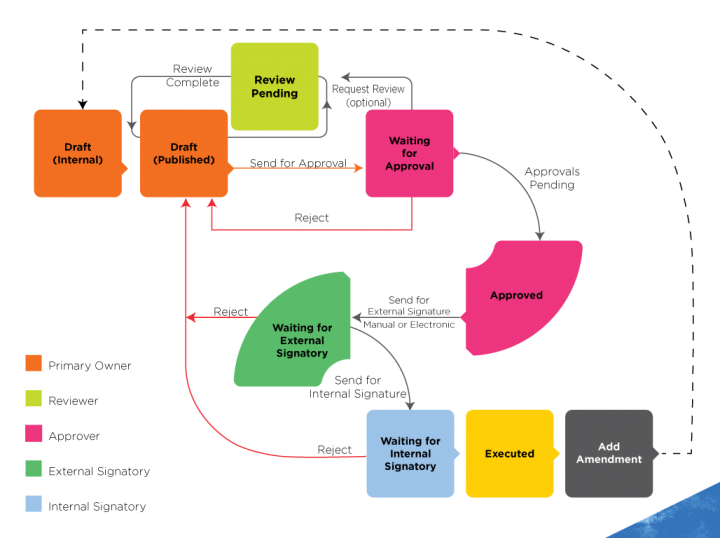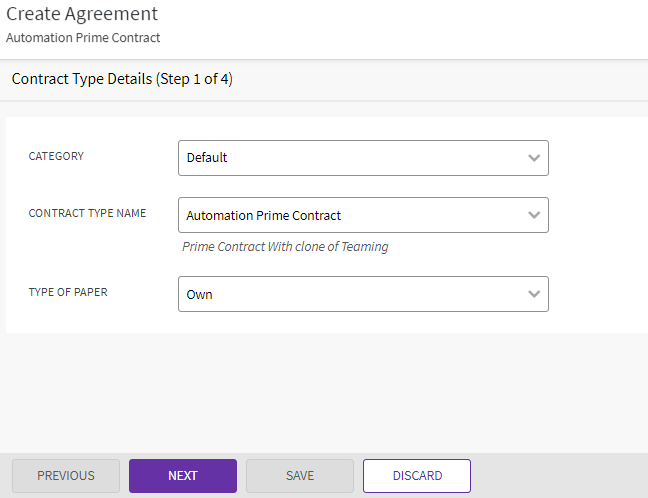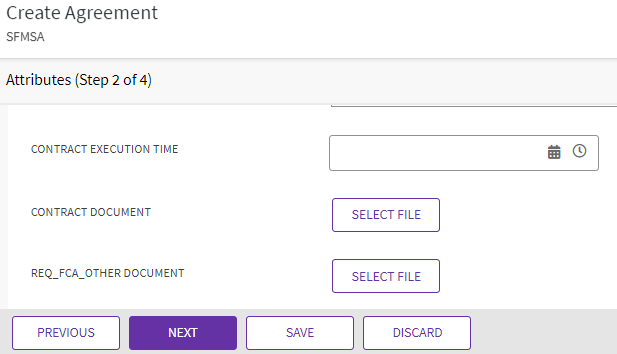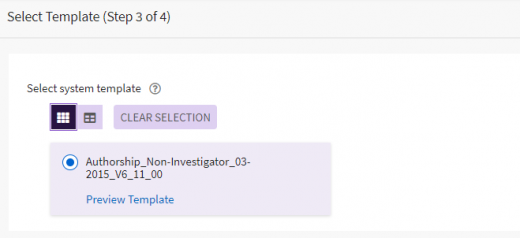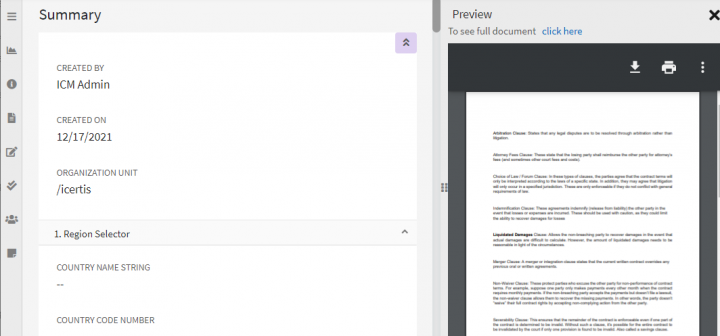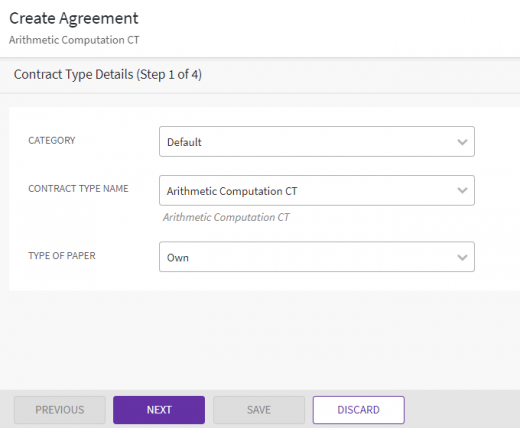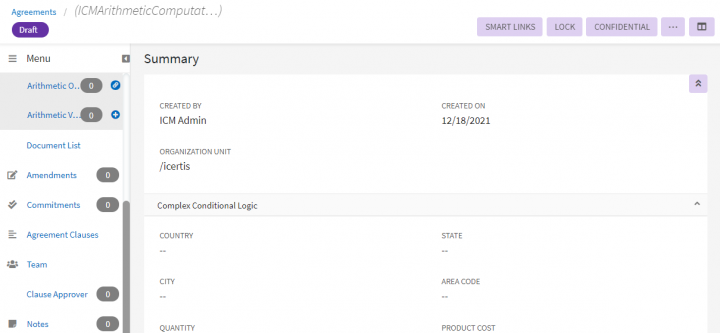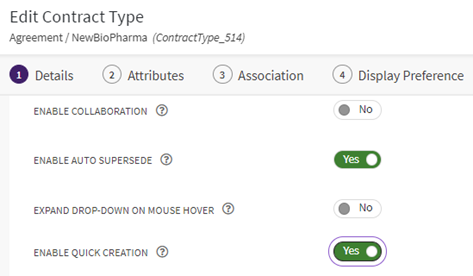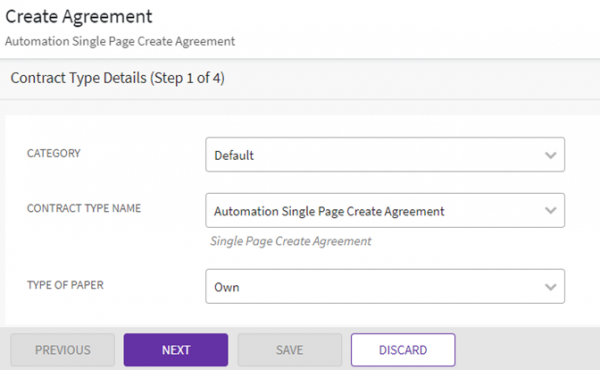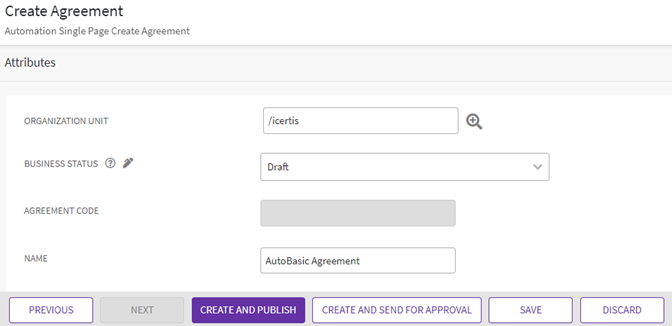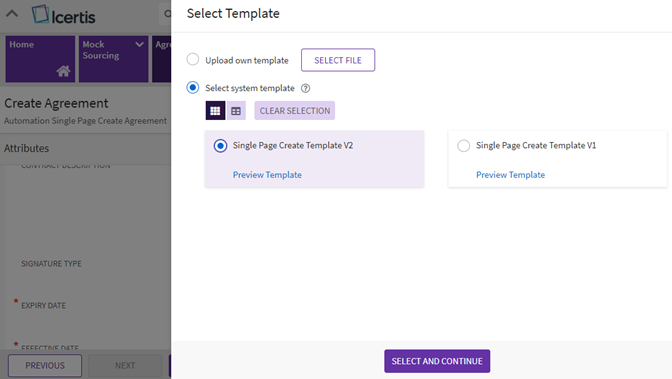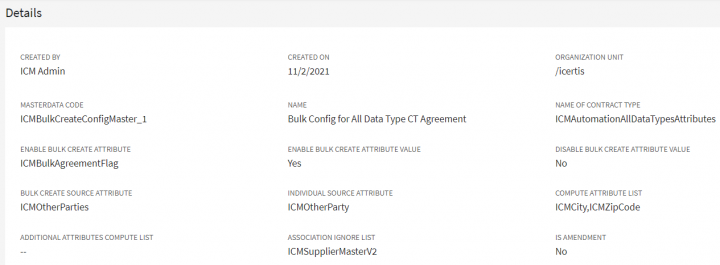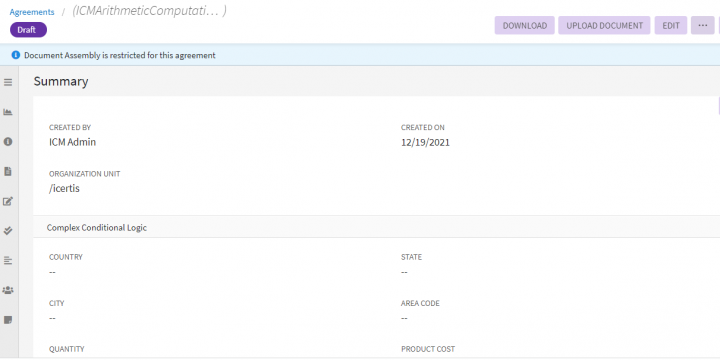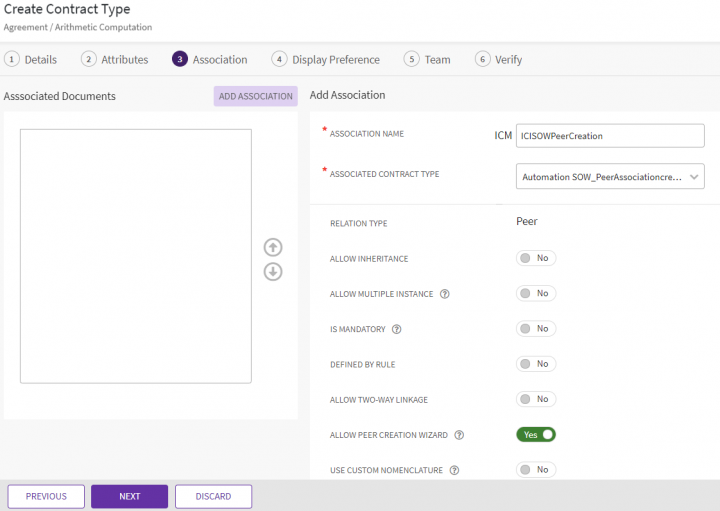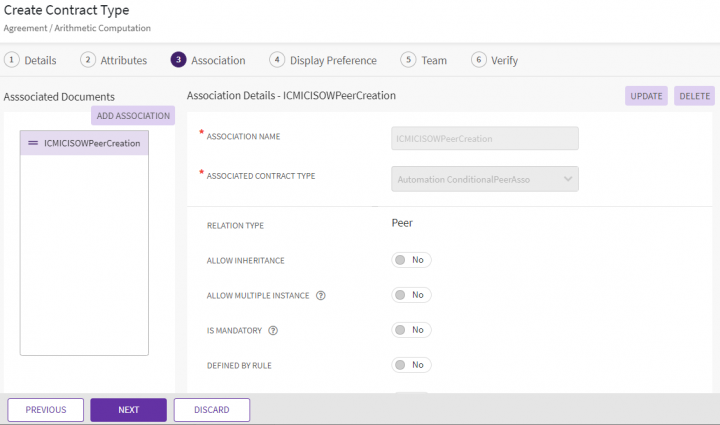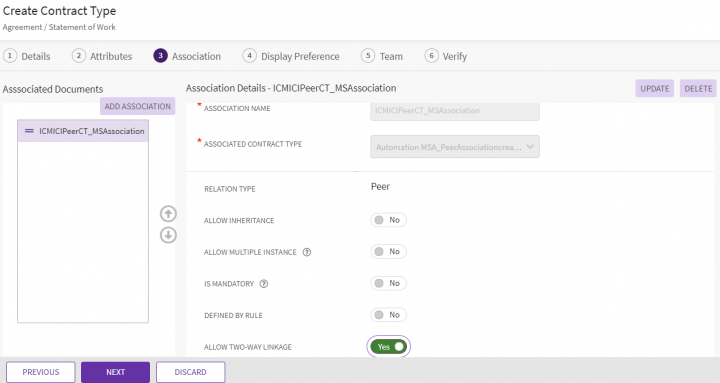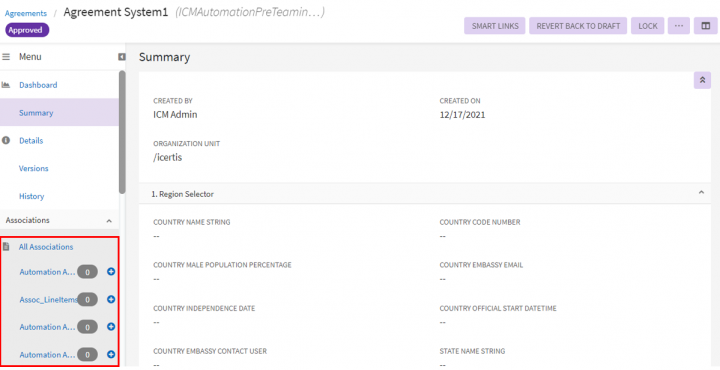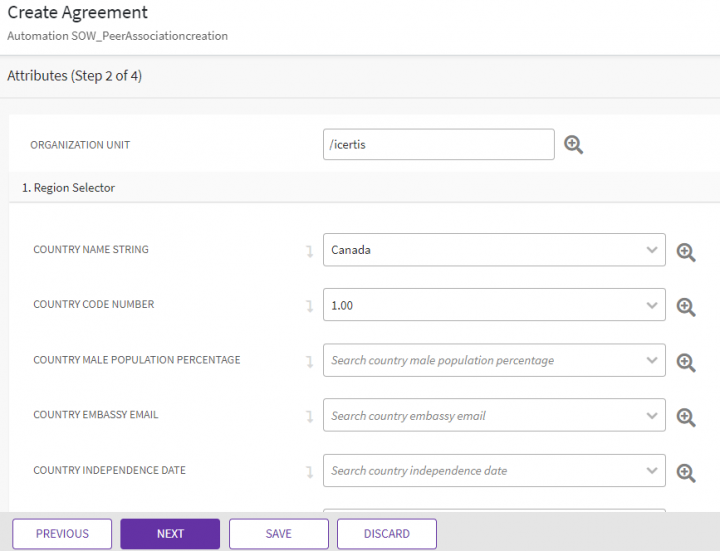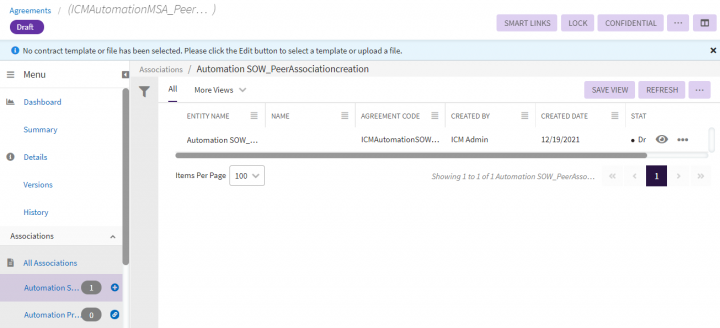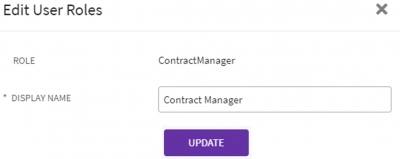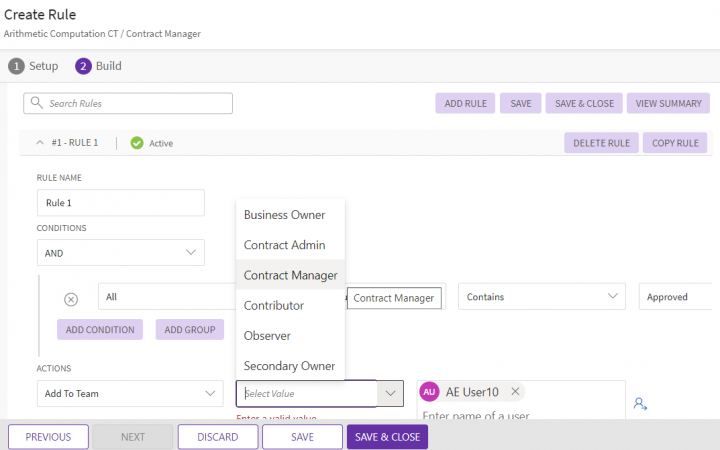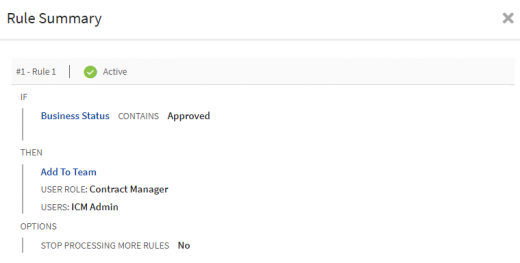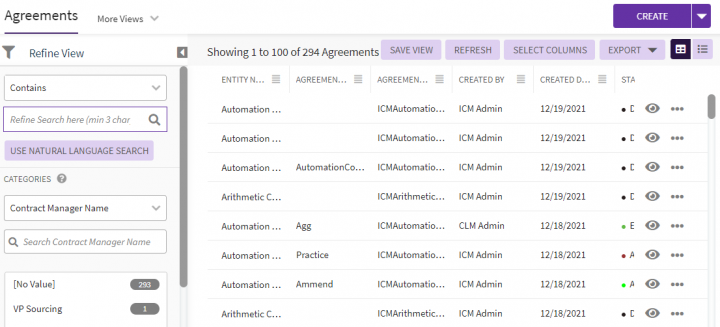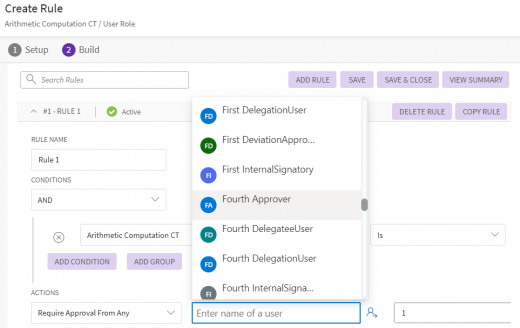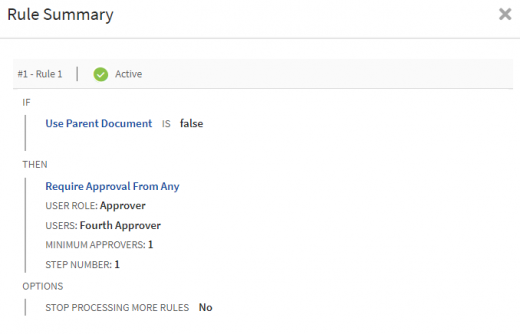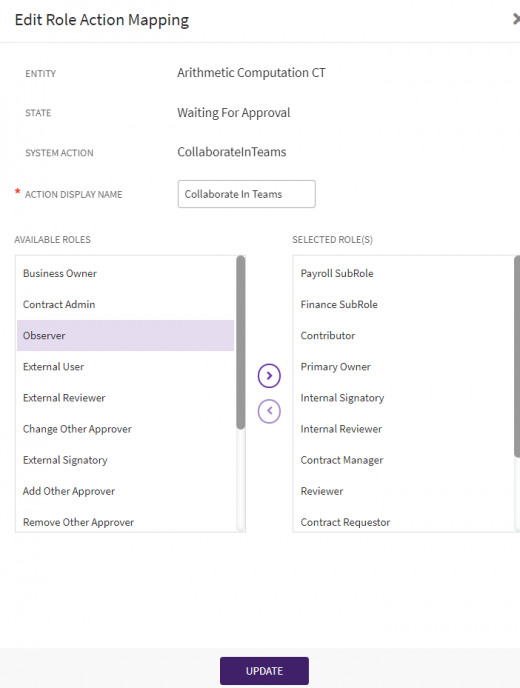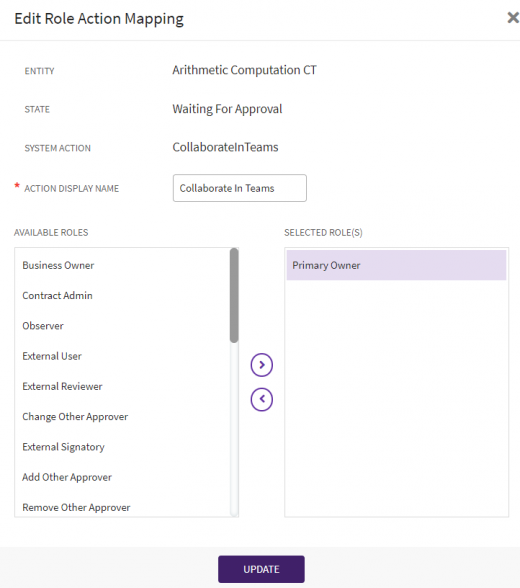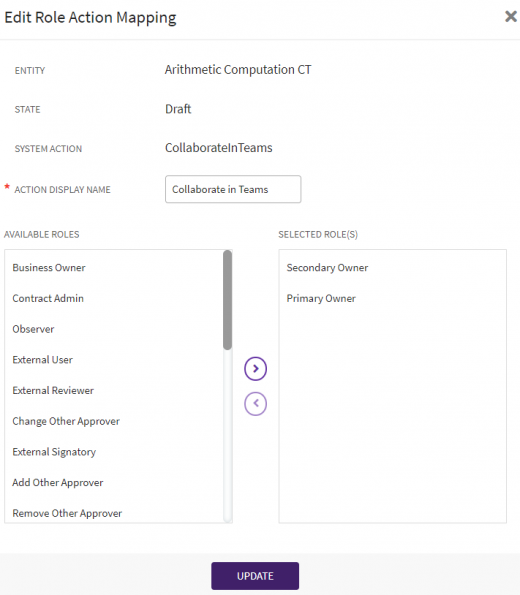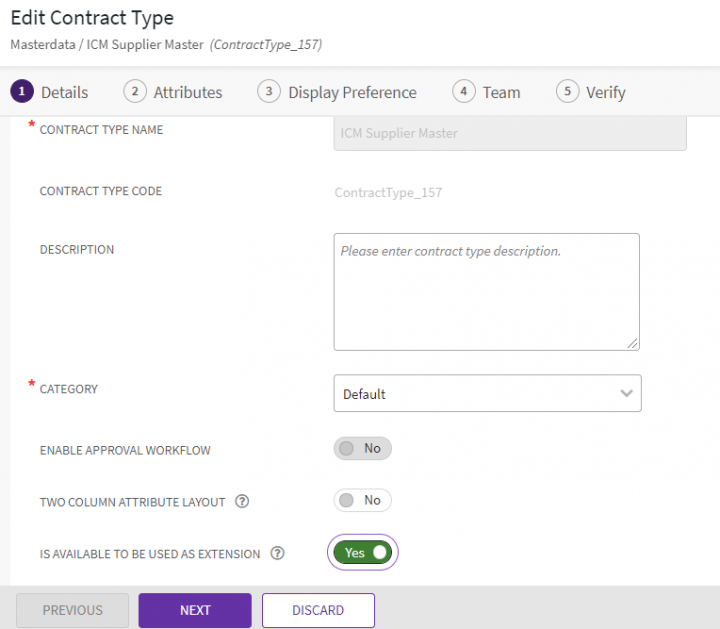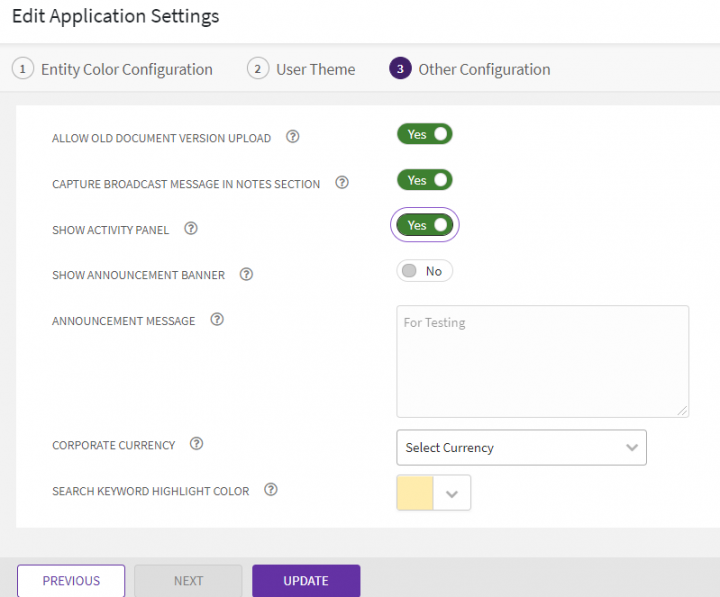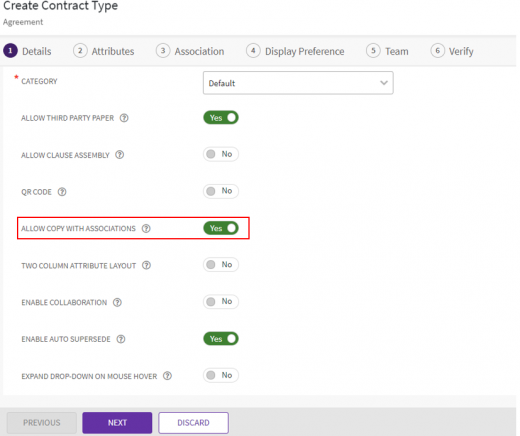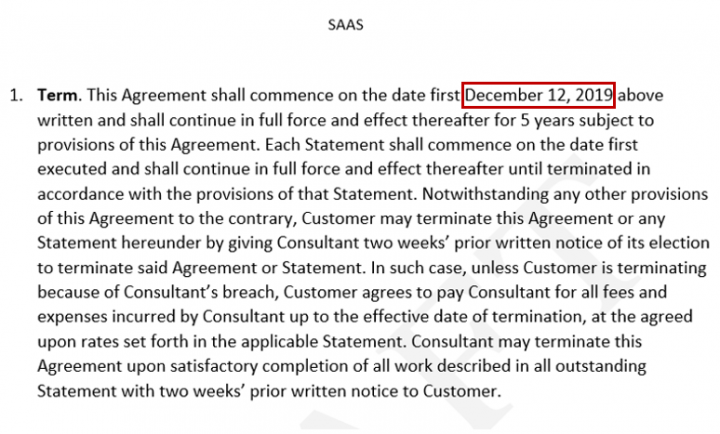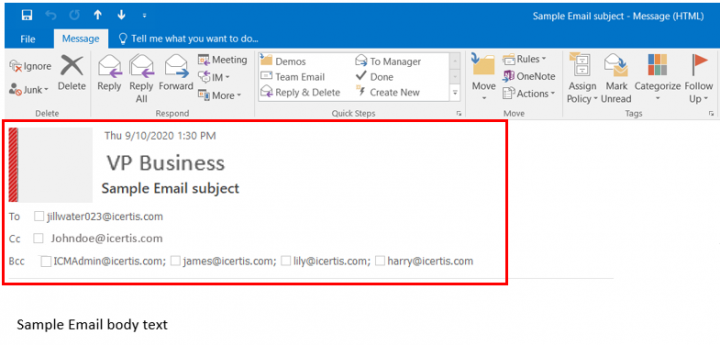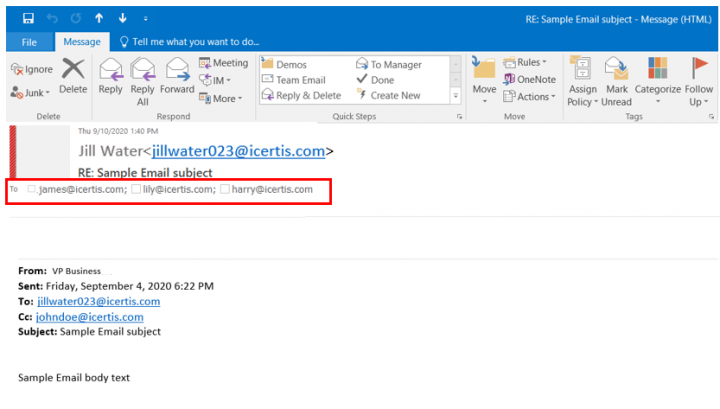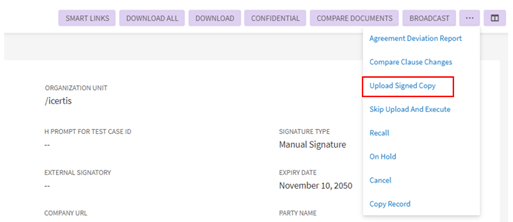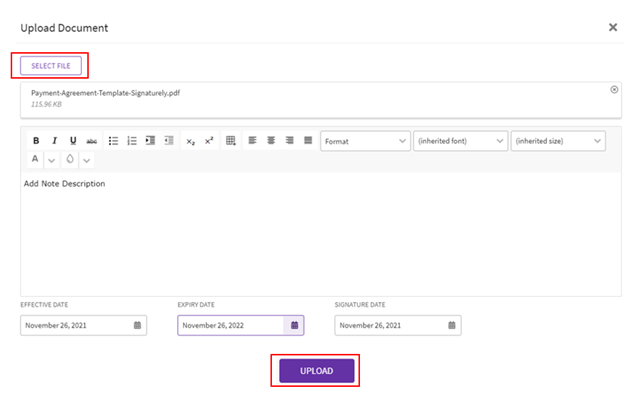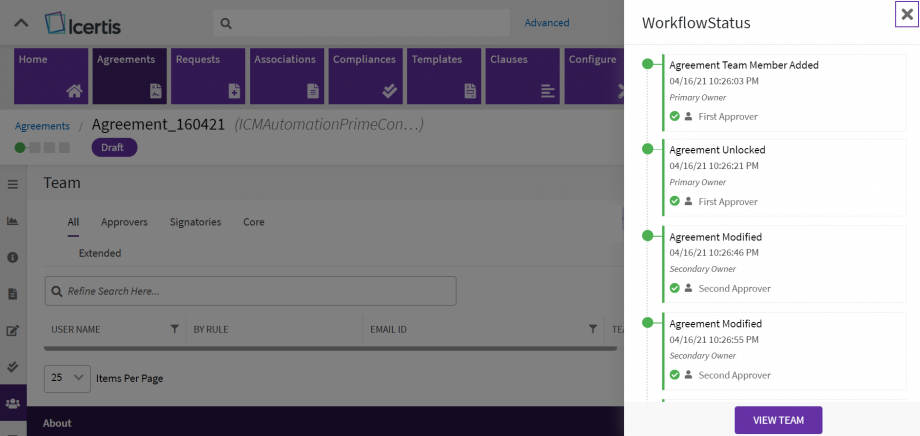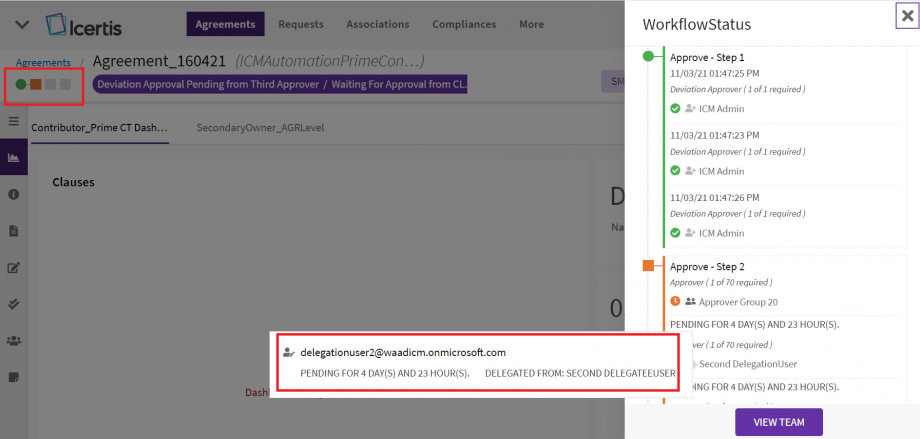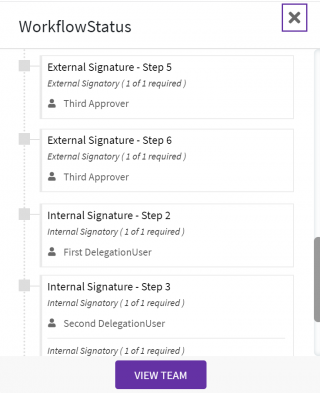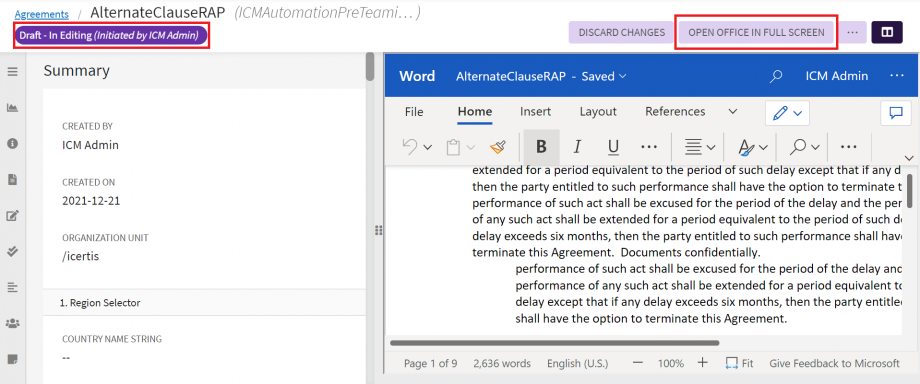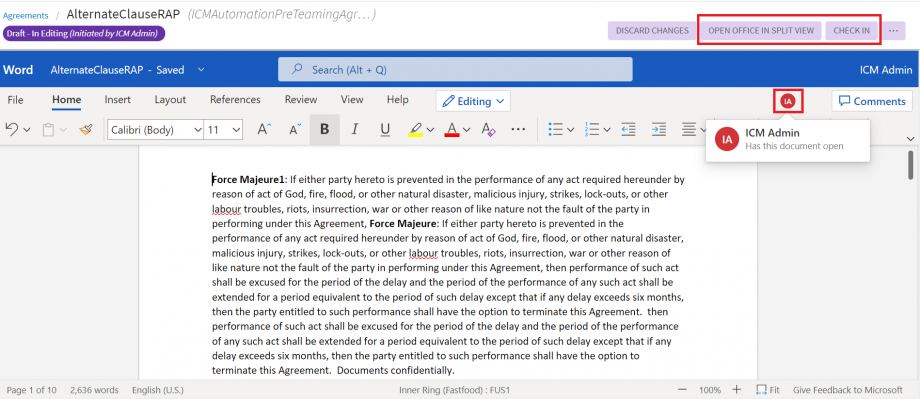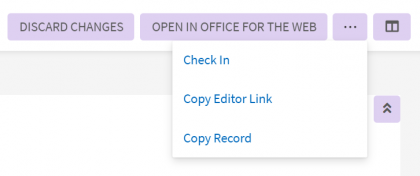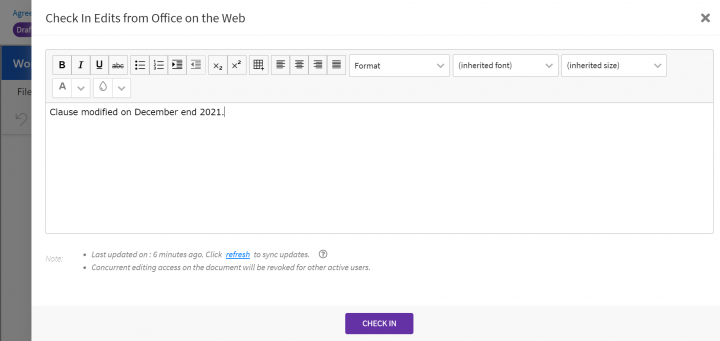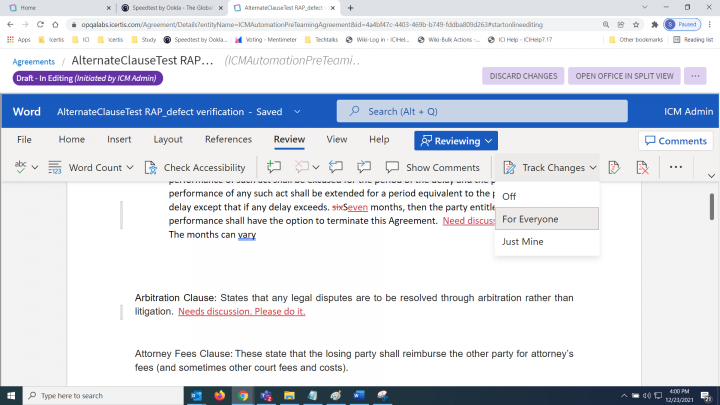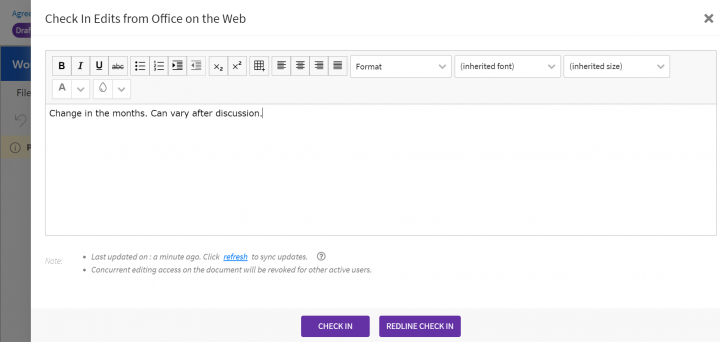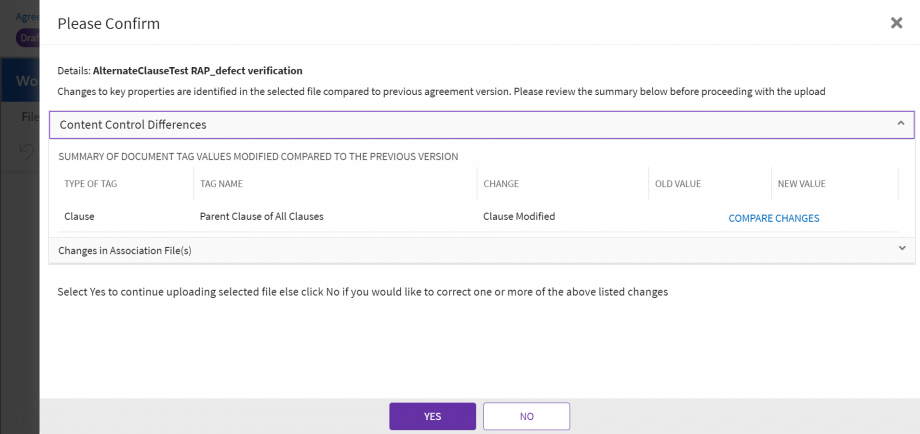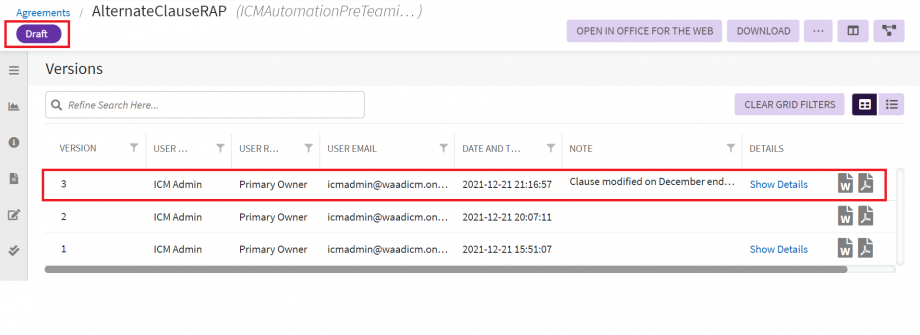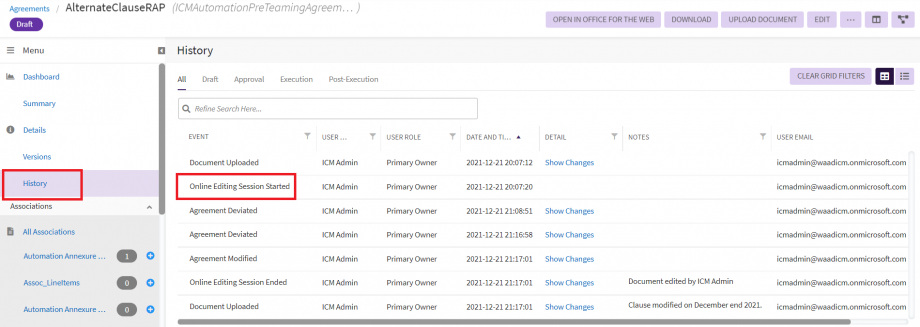Contents
- 1 Agreements
- 1.1 Creating an Agreement
- 1.2 Creating agreements quickly
- 1.3 Creating multiple agreements from a single agreement
- 1.4 Creating peer agreement from base agreement
- 1.5 Adding Contract Manager role for agreements
- 1.6 Ability to support Approver Sub-roles
- 1.7 Flexibility to control the Agreement actions based on the user role
- 1.8 Adding Static and Dynamic Filters
- 1.8.1 Ability to have flexible contract type extension
- 1.8.2 Defining access for extension attributes actions using Role Action Mapping
- 1.8.3 Defining access for extension attributes using Attribute Group Privileges
- 1.8.4 Making the contract type available for extension attributes selection
- 1.8.5 Creating Agreement and Associated Document instances with flexible entity attributes
- 1.8.6 Saving the extension attributes selection as a template
- 1.8.7 Setting a template as default for associations
- 1.8.8 Audit with Extension attribute
- 1.8.9 Saving a search with extension attributes
- 1.9 Using the Activity Panel
- 1.10 Canceling an Agreement
- 1.11 Editing an Agreement
- 1.12 Copy the Existing Agreement
- 1.13 Word Document Compatibility between two different ICI Instances
- 1.14 Collaboration in Contracts
- 1.15 Creating a new Topic and sending Messages by Internal user and External user
- 1.16 Replying Messages
- 1.17 Email Notifications to Participants
- 1.18 Searching Messages
- 1.19 Closing the Topics
- 1.20 Performing Bulk Actions on Agreements
- 1.21 Ability to configure Reminder Notification on Entities
- 1.22 Capturing user emails to send notifications
- 1.23 Labeling agreement document versions as per signature copy
- 1.24 Ability to approve a contract from email
- 1.25 Ability to update dates while uploading signed copy
- 1.26 Upfront Chevron View of Agreement Journey
- 1.27 Online editing of contracts
- 1.28 Online Editing for Associated Documents
Agreements
The "Agreements" or Agreement index page displays all the Agreements that you are associated with in one way or the other. You may have created an Agreement or you may be a member of the team that is working on the Agreement. This page displays the most current version of an Agreement regardless of its status.
From this page you can:
- Search Agreements in several ways. You can Search Agreements using the Search tile or use the Advanced Search page.
- View pinned saved searched by Administrator. If you are logging on to ICI for the first time, you will see saved searches pinned to your Agreement page. These pinned searches are applicable to the User Group you belong to and will remain unchanged, unless you modify them. The saved searches are created by the Administrator for the User Groups and pinned to the Agreements page by the application. A maximum of six searches can be pinned. Once you modify any of your pinned searches, your preferences override the Administrator’s preferences.
- View details of an Agreement by clicking the View Record icon. The details are displayed on the Agreement Details Page.
- View the document to see what the printed Agreement would look like by clicking the View Document icon. Thus, you can quickly find the required Agreement record without opening each Agreement record to view the document. If the Agreement is in Draft state, the preview only displays the attributes defined in the Agreement. If it is in an Approved state, then it also displays the actual values of those attributes. You can print the document or export the Agreement attributes to the desired format.
- View Smart Links to link related documents to one another by clicking the View Smart Links icon drop-down. For example, if there are several Agreements with the same vendor, you can link all of them through smart links to see the types of Agreements that are currently in force with that vendor. See the Creating Smart Links page for details.
- Perform Bulk Actions on Agreements.
- Configure default columns and their sequence on the Search and Index pages throughout ICI for all the users. The configuration can be done for each Entity as well as Contract Type thus offering complete flexibility to define columns as per your business needs.
- Configure multiple mandatory and non-mandatory filters at Contract Type level for inheritance by which agreements can be filtered. This is achieved through a technical configuration at the contract type level.
Creating an Agreement
You navigate to this page from the "Home" page by clicking the "Agreements" tile > "Create" button.
On this page, you can do the following tasks:
- Specify basic details of the Agreement
- Select Attributes
- Select a Template to use for creating the Agreement
- Publish the Agreement
- Send the Agreement for approval
You can create Agreements in ICI in the following ways:
- Copy an Existing Agreement and make changes to the copy.
- Create an Agreement from a Contract Request.
- Create a new Agreement by using the "Create" button on Agreements page. This help page describes this process.
The following figure shows the different states of an agreement with various roles that are involved in creating it.
Figure: Agreement workflow and various roles involved at different states of the Agreement.
To create a new Agreement, complete the details for the sections mentioned below:
- Contract Type Details
- Attributes
- Select Template
- Verify
Click "Next" at the end of each section to go to the next section and complete creating the Agreement. You can also "Save" a section at any time and return to this page to complete your Agreement.
Contract Type Details
Enter the following basic details of the Agreement in this section:
- Category: categories are created by the administrator and they are similar to labels; useful for organizing your agreements. The drop-down shows all the categories that were chosen while creating the Contract Type. Select one.
- Contract Type Name: shows a list of all the contract types that were created for the chosen category. The Type of Paper option is displayed depending on the contract type definition.
- Contract Type Description: This field facilitates users to select the desired Contract Type.
- Type of Paper: indicates if your own or a third party template should be used for creating this agreement. Provide your template if you select Own. Select Third Party option when you want to create the agreement by uploading a template agreement provided by the vendor or the provider. Few points to remember when selecting third party paper:
- should be used mainly when dealing with legacy contracts
- in case of a deviation, the deviation approval becomes a manual process in ICI,
- are uploaded as a PDF, DOCX, PPT and PPTX making it difficult to analyze them. As a result, attributes may have to be manually created in ICI (which can be time-consuming) or ICI may have to be used with limited functionality.
If the Type of Paper is Own, the Select Template page with a list of templates is displayed for the selected Contract Type. If the Type Of Paper selected is Third Party, the Select Template section is not shown. Instead, you would manually upload a third party agreement. You cannot use Own paper with this option.
Attributes
This section captures important details of the agreement that you are creating. Note that the attributes shown on this page will vary depending on the Contract Type that you selected. Below is an explanation of some of the less obvious attributes.
- Associate and Inherit: Click the icon to associate that agreement and inherit all its attributes to the agreement that you are creating. This field is displayed only for those contract types that have an association with any other contract type.
- Organization Unit: Select the organization unit you would like to create this agreement in. Users within an organization unit must also have certain privileges. With a Vi'ew privilege, users can only view agreements but users with Manage privilege can perform actions on the agreement. For example, if John and Mary share one organization unit, then for John to have access to Mary's agreements, John needs view privilege on her agreements. View privilege is also required for users to search a particular agreement.
- Name: Type a name for the Agreement you are creating. To make it easier for users in the organization to find your Agreement, the name should include some basic information about the Agreement. Basic information could include details such as the purpose of the Agreement and with which vendor this Agreement was entered in to.
- Contract Value: Type the value of the contract or set it using the controls provided. Selecting a currency is mandatory.
- Agreement Code: Each agreement is assigned a unique agreement ID in ICI, known as its Agreement code. The system automatically generates the Agreement ID when you click the "Create" button in the 4. "Verify" section.
- Signature Type:
- Manual Signature: Select if all signatories will sign the agreement manually.
- Electronic Signature: Select if all the signatories will sign the agreement electronically.
- Fully Signed: Indicates that all signatories have signed the agreement document.
- Click to Sign: Select this option so that the user can see an online preview of the agreement, which can be used to mark the agreement as signed and executed.
- Hybrid Signature: Select if both manual and electronic signatures will be used. Note: When selecting Signature Type as Hybrid Signature, the Signature Sequence is by default “Mixed Signature”.
- Signature Sequence: Select the sequence in which the agreement will be signed: External First, Internal First or Mixed Signature.
- Is Amendment: Specify if this Agreement is being created as an amendment for an existing agreement.
- Multi-Party: Specify if this Agreement involves multiple parties. For example, if the organization this agreement is being created for uses a sub-contractor, then this agreement would be marked as multi-party, as the sub-contractor details would also have to be captured.
- Previous Agreement ID: If this agreement is an amendment or a renewal of an existing agreement, use this field to add a smart link to the existing agreement.
- External Signatory: Click the "Add User" icon. The "Select User" window opens. If the External user is already provisioned you can select that user from the list, or click the "Add External User" button. The "Create External User" window opens. Enter all the mandatory fields such as, Name, Email Address and Language. It’s important to select the appropriate language for the user since the user will receive all the ICI notifications in the selected language. Click "Save", the user gets added as an External Signatory.
- File Path: specify the path from where you want to upload the third party template. This field is displayed only when you select Third Party paper on "1. Contract Type Details" section.
- Custome File Path: You can add additional user defined file selection attributes to the agreement contract type. Also, it is possible to configure such user defined file selection attribute as read-only to further safeguard the uploaded documents when sent for review to the external Stakeholders. You can do this by enabling the "Is_Editable" attribute property. Business users cannot edit the uploaded documents; however, they can still preview and download these read-only documents. System can still attach a file through a read-only file selection attribute through backend tasks or API integrations.
File scanning during upload:
When configured, this will help to scan files for any malware and protect ICI against a wide variety of threats whenever a user uploads a file using the "File Upload" attribute in ICI or a file is uploaded through an API.
- The next page in the workflow opens if the files are safe.
- The current page is displayed again if any file has malicious contents.
Note:
- Any ICI entity (such as agreement, associations, template, clause, masterdata and so on) that takes file as an input in any mode, the virus scan is performed by default for that entity before uploading file into the ICI.
- Files can be scanned in bulk.
- File scanning while uploading through Word and Excel plugins is handled through API.
Template
This section displays the Templates that you created for the selected Contract Type. This section is displayed only if you select Own paper to create the agreement on the Contract Type Details section. Select the appropriate Template. Template Selection page displays all the applicable templates in a Grid view by default. Clicking on the row having the desired template selects the template. Clicking again on the same row deselects it. You can switch between the Grid and Tile views as desired and if any selections exist, these are retained between any view switches.
The Templates listed in the Grid view includes columns based on template metadata such as, template name, template status, etc. or extended template metadata if configured in your instance. Through a technical configuration, you can specify which columns should display on the grid.
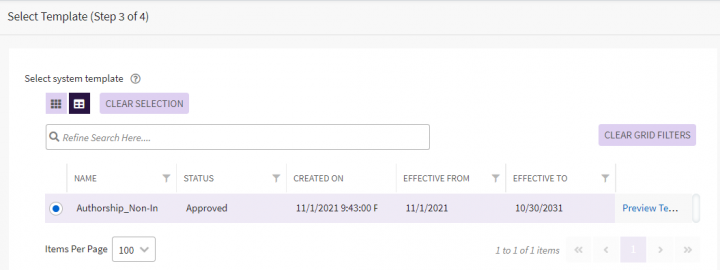
• The template preview displays the directly added Clauses and Attribute/Association placeholders, but does not display any rule based clauses that have been added to the Template.
• For a new Template that is currently being used, the latest approved version is displayed in the preview.
• When editing an Agreement and the template has been previously selected, ICI displays the content from the version of the template that was used at the time of original selection. For example, a user is trying to edit an agreement for which v2 of the MSA template had been used. The current version of the approved MSA template is v5. Now when the user is editing the agreement and chooses to preview the selection of the MSA template, the product shall display the contents as of v2 of the MSA template. There shall be no difference between the contents of the template displayed in the preview and the agreement document that gets generated except for addition of any rule based clauses and associations.
Refer to Template Management for complete details on creating, editing, uploading and working with Templates.
Verify
This is the final section for creating an agreement. It displays only the sections and attributes that you used to create this agreement. Verify all the details you have entered.You can:
- Click the "View" icon beside the files you uploaded on the "Attributes" page to preview. The "Preview" is available for documents in .docx, .pdf, .ppt, .pptx, .msg and Images (.jpg, .jpeg, .png and .gif), xls and .xlsx file formats.
- Click "Discard" to abort the creation of this agreement.
- Click "Previous" to go back and make any changes. Click "Next" to return to this section after making the required changes.
- Click "Create" to create the Agreement. The Agreement is not visible to anyone yet (as it is not published) and you can continue creating or editing it on the Agreement Details Page.
- Click "Create and Publish" to create and publish the Agreement. After the Agreement is published, other users with adequate access can search, view, and take actions on the agreement. After publishing, a Draft watermark appears on the Agreement in all states until it is approved. The watermark gets removed after the agreement is approved.
- Click "Create and Send for approval" to create and send the Agreement for approval. The Agreement gets sent to approvers that are set by a rule on the Contract Type selected for this Agreement. The state changes to Pending Approval. If no rules are set and no approvers are defined, the Agreement status automatically changes to Approved.
Ability to preview agreement before publishing
There is a preview functionality, so that the primary owner or contract creator can review whether the selected template is appropriate, the rule-based clauses have been correctly added to the agreement, among other factors, and make changes to the agreement before the version is created. The preview document would also include tagged associated documents, coming through inline or inheritance associations.
A preview section is available on the “Verify” stage of agreement creation, before publishing or updating the document. The PDF preview is for indicative purposes only and is not an agreement version.
To view the agreement before creating or editing the document:
1. Create an agreement and complete the Contract Type Details, Attributes and Select Template pages of the wizard.
2. Click "Next". The "Verify" page opens.
3. Click the Document Preview tab on the right. The Document Preview section is displayed alongside the Verify page.
Note:
- Any associations or inline associations (whether tagged as file or table) will also be included in the preview.
- If the user navigates back to the Select Template page and chooses a different template, the preview displays the latest selected template.
- Only the latest version of the document is displayed in the document preview.
The Administrator can configure access control for users who are not part of the team to sections/ sub-sections in the left navigation pane at the contract type level. The non-team users are generally at a higher level in the organization and want a quick glance at the contract.
This can be achieved through a backend configuration for the non-team user role in panel mapping as required and is applicable to agreements, amendments, contract requests and associations.
Let’s consider an example where a team member who is at a lower level of the Organization Structure, such as Automation user5, creates an agreement.
1. Click Home > Agreements> Create. The "Create Agreement" page opens.
2. Click Next. Enter and verify all details for the following tabs.
3. Click Create. The Details page opens with the agreement in Draft status. Note that the user Automation user5, who is at a lower level in the organization chart (an engineer at level 5 of the hierarchy) but part of the team, has access to all the tabs includingTeam and Notes.
The user Abe Kim will see all other tabs except for Team and Notes tabs.
Creating agreements quickly
1. Navigate to the desired Contract Type & click the “Enable Quick Creation” flag on from the “Edit Contract Type” page.
2. Navigate to Agreements page and click “Create”. The “Create Agreement” page opens.
3. Fill out the attribute details.
4. Click “Create and Publish”, or “Create and Send for Approval” to create the agreement directly from the “Attributes” page. The “Select Template” drawer opens.
5. Select a template from the “Select Template” drawer.
a. Preview the template on the same page, by clicking on the “Preview Template” link, which will open in another drawer over the main template selection drawer.
6. Click “Select and Continue”. The agreement is now created without any further steps.
Quick Create Conditions
Agreements will not go through the Quick creation process if the following conditions exist:
- The Contract Type is configured for Page Navigation and there are active Masterdata records for the Page Navigation, with the attribute page name.
- The Contract Type has any of the following active Rules:
- Extension attribute rule.
- Dynamic attribute rule.
- The Contract Type is associated to any approved, active template consisting of template variables.
- The Contract Type has the inline-associations configured.
Creating multiple agreements from a single agreement
You can create multiple agreements from a single agreement with the provision of copying associations and attributes as required.
Users now:
- Have complete flexibility at configuration level to define the applicable contract type, decision attribute, compute attribute for bulk agreement creation
- Have the option of bulk agreement creation in the model agreement based on the above configuration with provision to define unique batch Id for all the agreements created using a single model agreement
- Can access model agreements only through technically configured Admin saved search.
Bulk created agreements are created in Draft status by default. However, users can send agreements for approval as part of the bulk creation process by configuring an attribute added in the bulk configuration masterdata contract type. The bulk agreements will then be created in Approved or Waiting for Approval status.
Note: Amendments can also be sent for approval using the same functionality.
Configuring Bulk Agreement
Users are required to use the instance of seeded masterdata contract type to enable bulk agreement creation. The seeded masterdata attributes and their description are explained here briefly. For information about how to configure a masterdata contract type for bulk creation, see the Configuration Guide for Bulk Agreement.
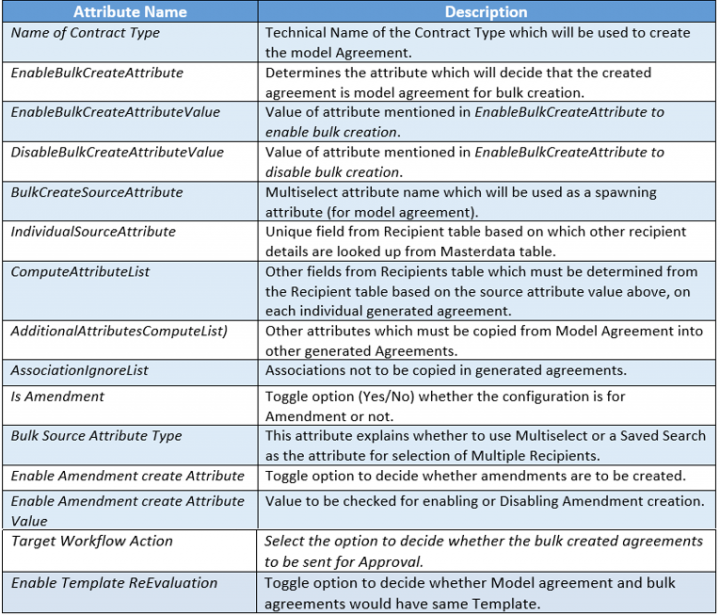
The seeded masterdata attributes in ICI:
Creating Bulk Agreement
Let us consider an example where we create an agreement using the contract type Automation All DataTypes Attributes which is already configured for the bulk creation.
1. Click the "Agreements" tile on the Home page. The "Agreements" page opens.
2. Click the "Create". The "Create Agreement" page opens.
3. Select the Contract Type Name. For example, Agreement CT with Arithmetic Computation CT.
4. Select Type Of Paper as Own.
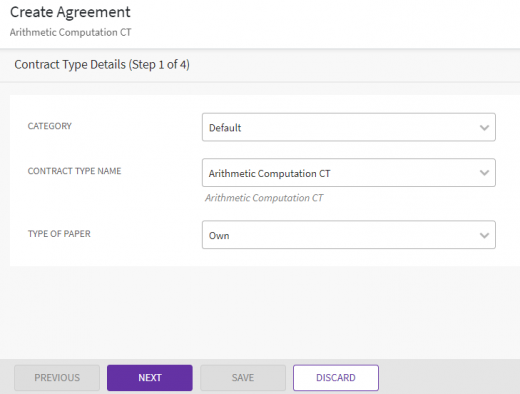
5. Click Next. The Attributes tab opens.
6. Select Yes from Enable Bulk Agreement Creation drop-down list.
7. Select parties from the Other Parties drop-down list. For example, Other Party 01, Other Party 02, & Other Party 03.
8. Enter All Data in the Test Case Id field.
10. Select All Data Types Basic Template.
11. Click Next. The Verify tab opens.
12. Click Create and Publish. The Details window opens. The agreement changes to Draft state.
13. Click the three dots icon to view more action buttons on this page.
18. Click the "Agreements" tile.
20. Select the batch identifier from the drop-down list.
All three agreements (Other Party 01, Other Party 02, & Other Party 03) are created using Bulk action. The Agreements created using Bulk action are in the Draft state and users are notified regarding the success and failure of agreements created.
Creating peer agreement from base agreement
You can also create peer agreements directly from within their associated base agreement inheriting all the attribute values of the base agreement. For example, you can create a SOW directly from the MSA. This is achieved by enabling the following flags - Allow Peer Creation Wizard, Allow Multiple Instances andAllow Two-Way Linkage.
Consider an example of creating a peer-peer association (of SOWs) from within the base agreement (MSA).
Creating the base contract type
Let’s create a base agreement such as an MSA.
2. Select Agreement.
3. Click Next. The Details tab opens.
4. Enter a Contract Type Name. For example, Automation MSA_PeerAssociationcreation.
5. Click Next. The Attributes tab opens.
6. Select the Available Attributes and move to the Selected Attributes column.
7. Edit the attributes as required. Click Save.
Creating an association of the base agreement
Let’s create an association of the base agreement as a peer such as a SOW.
1. Click Next. The Associations tab opens.
2. Click + Association.
3. Enter an Association Name. For example,ICISOWPeercreation.
The Associated Contract Type is automatically populated and Relation Type is Peer.
4. By default, all flags are set to No. You may set the flags to Yes as required. However, the following flags must be enabled:
- Toggle the Allow Peer creation wizard flag to Yes. This allows the user to create the peer association instance and directly link it to the base agreement. In this case, the association ICISOWPeercreation will directly be linked to the base agreement Automation MSA_PeerAssociationcreation as a peer.
- Toggle the Allow Inheritance flag to No.
- Toggle the Multiple Instance flag to Yes to create multiple peer agreement instances in the base agreement.
- Toggle theAllow Two Way Linkage flag to Yes for both the base and peer assocaition. This creates a two-way linkage so that the peer association gets linked to the base agreement and vice-versa.
Peer agreement can also be created from within the base agreement in Executed state.
The configuration key “Core.Agreement.StatesToAlowPeerAssociationsPostExecution” is used to create the association from the executed state of the base agreement.
5. Click Save. The created association ICMSOWPeercreation will be displayed in the Association list on the left hand side.
6. Click Next. Enter the required details in the following tabs.
7. Verify all the details and click Create. The Contract Type Details page opens.
8. Click Send For Approval. The Configure page opens listing the created Contract Type - Automation MSA_PeerAssociationcreation in an Approved state.
9. Click the View Details icon next to this entity to view the contract type details.
Creating association for peer contract type
Create a peer contract type in the similar way as mentioned in section 1. For example, Automation SOW_PeerAssociationcreation.
Then create an association of the base agreement under peer contract type Automation SOW_PeerAssociationcreation.
1. Click Next. The Associations tab opens.
2. Click+ Association.
3. Enter an Association Name. For example,ICIPeerCT_MSAassociation.
The Associated Contract Type is automatically populated andRelation Type isPeer.
4. By default, all flags are set to No. You may set the flags to Yes as required. However, the following flags must be enabled:
- Toggle the Allow Inheritance flag to Yes. This inherits the values from the base agreement into the peer agreement. In this case, the association ICMPeerCT_SOWassociation will directly be linked to the base agreement Automation MSA_PeerAssociationcreation as a peer.
- Toggle the Allow Two Way Linkage flag to Yes for both the base and peer contract type assocaition. This creates a two-way linkage so that the peer contract type association gets linked to the base agreement and vice-versa.
5. Click Create to create the peer contract type with MSA association.
Create multiple associations from base agreement
The base agreement MSA can have multiple associations (SOWs), but the associations (SOWs) can have just 1 parent agreement.
1. Create MSA agreement and go to Details page.
2. Under the Associations section in the left navigation pane, all the associations will be listed. Click the Add icon against a particular association. In this example, Assoc_LineItems.
The page will redirect the user to the new agreement creation wizard for Automation SOW_PeerAssociationCreation.
The contract type name will be auto-populated.
2. Select Own Type Of Paper from the drop-down.
3. On the Attributes page, attribute values from base agreement will get inherited into peer attributes.
4. Click Next on the following tabs.
5. Verify the details and click Create to create the agreement.
The peer agreement will get linked to the base agreement.
6. Click "View Details" icon next to the created agreement on the agreement index page. The agreement Details page opens.
The agreement details displays the peer to peer association from within the (MSA_PeerAssociationCreation) listed in the Associations tab.
Note:
- The base agreement can have multiple associations; however, the association can have only one base agreement. For example, base agreement is MSA and association is SOW, then MSA can have multiple SOWs, but SOW can be attached to only 1 MSA. This can be achieved by enabling the Allow Multiple Instances flag.
- When copying associations, creating peer to peer association from base agreement is disabled. Hence, the MSA will not be attached to the new SOWs.
Adding Contract Manager role for agreements
In the contracting process, a Contract Manager/Owner manages or owns the agreement and is generally different from the user who has created/ initiated the agreement. This user who is managing the agreement might change from time to time. For example, User A may have ownership during authoring process, whereas the User B might look after the agreement during the negotiation process.
Hence, the Contract Manager role has been introduced to manage agreement ownership throughout the agreement lifecycle.
With this release:
• Assignment of the user against Contract Manager role in the team can be only achieved through event rules using action Add To Team.
• Only one Contract Manager is available inside the agreement at any given point of time.
• The Contract Manager will have provisions same as that of primary owner.
• Contract Manager Name are displayed on the agreement Summary page.
• Agreements can be searched using the Contract Manager Name.
• Managing adhoc modification for Contract Manager role user will be restricted inside the agreement team tab similar to primary owner role user.
Viewing the Contract Manager role in ICI
To view the contract manager role:
1. Click Admin tile and then click User Groups > User Roles. The User Roles page opens.
2. Navigate to the section displaying the Contract Manager role.
3. Click the icon next to the Contract Manager to edit the Display Name of the Contract Manager role. The Edit window opens.
4. Edit the Display Name of the role and click Save. The display name for Contract Manager set here will be used across ICI such as on agreement details and summary pages.
Adding a Contract Manager to the Team
Add to Team condition is addition of users to a team after the particular event occurs. For example, addition of approvers after the Agreement Created event occurs.
You can add a contract manager to the team only using the event rule.
To add a contract manager:
1. Select the action as Add To Team and then select Contract Manager role from the drop-down and the appropriate user.
2. Click Next and then click Create to create the event rule.
Viewing Contract Manager in Agreement Team
You can view the contract manager added in the agreement team if the event rule is executed as expected.
Searching an agreement with Contract Manager role
Select the attribute from the drop-down on agreement index page to display the list of users with contract manager role.
Ability to support Approver Sub-roles
Users have the ability to define sub-roles for the Approver role. This flexibility enables all the capabilities of the Approver for the users at the sub-role level.
For example, you can now set different types of approvers for an agreement based on functions such as legal approver, finance approver, and so on. This can be achieved through a technical configuration.
Provisioning User
User roles can be provided while Provisioning users. For managing users, refer Managing Users
Creating a User Group
The user created above can create a User Group. For more information, refer Managing User Groups.
Creating a Rule for the sub-role
You can add a user for a sub-role by creating a Rule. The user Roles drop-down is only available for the Approval Rule and Notification Rule types.
1. Click "Configure" > Rules > "Create". The "Create Rule" page opens.
2. Select the Contract Type from the drop-down.
3. Enter the Rule Name and Rule Description.
4. Select the Rule Type. For example, Approval Rule. The Team Role field is displayed.
5. Select a Team Role for the user. For example, Approver.
6. Click Next. The Build tab opens.
7. Click the Add Rule button.
8. In the Action section, select Require Approval From Any.
9. Select the User Role from the drop-down. For example, Finance Approver.
10. Click the Search User icon to select a user for the sub-role. The Search User window opens.
11. Click Add after selecting the user.
13. Click Next. The Summary tab opens displaying details of the created Rule.
14. Click Create. The Rule created successfully message is displayed.
13. When the agreement is created, the user with the sub-role (Finance Approver) is displayed on the Team tab of the agreement Details page.
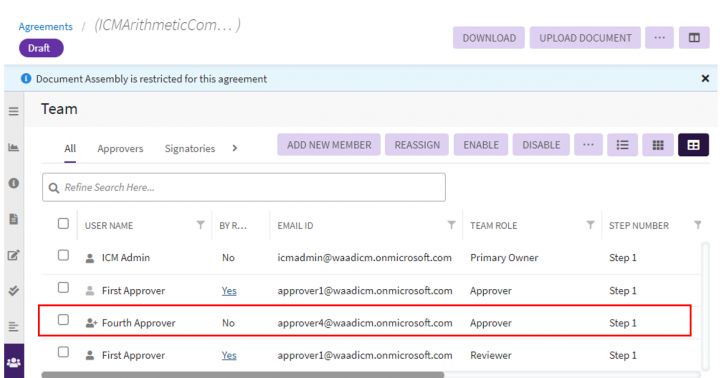
Creating a Subscription
Limitations of Approver Sub-roles
This functionality has the following limitations:
- Sub-roles can be defined for the Approver role only.
- The following sub-roles are supported in the workflow of User Group, Agreement, Amendment, Associated Document, Rule creation based on Approval Rule, Subscription, Notification, Auto-delegation, and Broadcast from the Agreement Details page.
- When the sub-role for the Approver role is defined in addition to the existing Approver role, in that scenario all roles new and old are supported unless the user disables the existing Approver role. ICI behaves as is and data migration with respect to the new and old role is not supported.
Flexibility to control the Agreement actions based on the user role
The access control for Agreements and Amendments has been extended to control additional agreement level tasks and actions based on the user role.
Users can control:
- The agreement actions such as Compare Documents, Compare Clause Changes, Broadcast and so on
- Creation and disassociation of associated documents from an agreement
- Linking and disassociation of peer association from an agreement
- The visibility of the individual reports available on the agreement details page is controlled through technical configuration
Controlling the actions available on the agreement details page using the Role-Action Mapping
Consider an example where the agreement Automation AssoTwocolumn has the user added in the team as Approver. The agreement action Broadcast has the user role Approver mapped for the agreement in Draft state. If you remove the role approver from this role-action mapping, he or she will no longer has the access to the Broadcast action on agreement page for Draft state.
Click on the Team tab in the left panel configuration on the agreement details page to view the users added in the team. For example, user Fourth Approver is added as Approver for the agreement Automation AssoTwocolumn.
The role-action mapping for the agreement Broadcast action for Draft state has user role Approver mapped.
Now remove the user role Approver from the Broadcast action and Draft state.
To edit the role action mapping:
1. Click "Admin" > User Groups > Role-Action Mapping on the Home page. The Role-Action Mapping page opens.
2. Select entity in the Select Entity field. For example, agreement Automation AssoTwocolumn. The list of all Role-Action mappings applicable to the agreement opens.
3. Click Edit icon next to the action for particular state you want to edit. For example, action Broadcast for state Draft. The Edit window opens.
4. Add or remove the User Roles in the right section with the help of arrows. For example, remove user role Approver from right section.
5. Click Save. The role is removed from the Roles column for selected action and state.
The user with role Approver will then not be able to view the action Broadcast for the agreement in Draft state.
Controlling the Associations actions on the Agreement page using the Role-Action Mapping
The access to the associated documents of the agreement can be controlled by role action mapping.
Only authorized users can:
- Add associations to the agreement from left panel configuration on the agreement details page
- Dissociate the associated document from the agreement from grid page.
Create Associations instances from Agreement details page
To control access on the associations creation action from agreement details page through role-action mapping:
1. Click Admin > User Groups > Role-Action Mapping on the Home page. The Role-Action Mapping page opens.
2. Select entity in the Select Entity field. For example, Automation Annexure Assembly (Associated Document Contract Type). The list of all applicable role-action mappings opens.
3. Click Edit icon next to the action for particular state that you want to edit. For example, Create Association From Parent. The Edit window opens.
4. Add or remove the User Roles in the right section using arrows. For example, add Primary Owner.
5. Click Save. The role is added to the Roles column for selected action and state.
The Create Associations action on the left panel configuration will be disabled for all users other than Primary Owner.
Controlling the access for Association instances from the Association grid
Only authorized users can edit, dissociate or copy associations from agreement-association grid page. These actions are controlled using role-action mappings defined for respective parent-child or peer-to-peer associated document contract type.
To control access on the association actions through role-action mapping:
1. Click "Admin" >User Groups> Role-Action Mappingon the Home page. The Role-Action Mapping page opens.
2. Select entity in the Select Entity field. For example, Automation Annexure Assembly (Associated Documents Contract Type). The list of all applicable role-action mappings of the association opens.
3. Click Edit icon next to the action for particular state that you want to edit. For example, Edit. The Edit window opens.
4. Add or remove the User Roles in the right section with using arrows. For example, add Primary Owner, Secondary Owner and Document Owner.
5. Click Save. The role is added to the Roles column for selected action and state. For example, For Arithmetic Computation CT, only Primary Owner and Secondary Owner can edit the Associations for Draft state.
When the user other than above roles tries to access the agreement, the Edit, Dissociate and Copy actions will not be visible to him from the agreement-association grid page.
For example, the Edit, Dissociate and Copy action are not visible to the users with approver role.
Adding Static and Dynamic Filters
You can add Static and Dynamic filters after configuring the filters on Masterdata records. For more information about Static and Dynamic filters configuration, refer Masterdata.
Ability to have flexible contract type extension
ICI provides the flexibility to select and use masterdata attributes as extensions to agreements and associated documents at the time of instance creation. Users can create rules to add or remove these extended attributes to agreement and associated documents. ICI capabilities support the extension attributes in the same way as normal attributes.
Users can:
- Configure conditional attributes, tracking attributes, computations (enable expressions) to use as extended attributes
- Save extension attributes selection as a template for reuse
- Control access privileges for extended attributes based on the user role
- Maintain audits for the extended attributes
Defining access for extension attributes actions using Role Action Mapping
The authorized users can control the access privileges for the actions Configure Attributes and Re-evaluate Rule on the Extension Attributes page during agreement creation through Role-Action Mapping.
1. Click Admin > User Groups > Role-Action Mapping on the Home page. The Role-Action Mapping page opens.
2. Select entity in the Select Entity field. For example, Agreement. The list of all role-action mappings applicable to the agreement opens.
3. Click Edit icon next to the action for particular state you want to edit. For example, Configure Extension Attributes for state Approved. The Edit window opens.
4. Add or remove the User Roles in the right column with the help of arrows. For example, add user roleBusiness Owner to the right column.
5. Click Save. The role is mapped under the Roles column for selected action and state.
Defining access for extension attributes using Attribute Group Privileges
Authorized users can restrict the access to extension attributes for specific users using Attributes Group Privileges.
To restrict the access:
1. Click Admin > User Groups > Attribute Group Privileges > Add on the Home page. The Add window to configure and add the attribute group privileges opens.
2. Select Copy from Contract Type. For example, RFQ.
3. Toggle Show Extension attribute Group to Yes.
4. Select Attribute Group for which you want to restrict the access. For example,Location Details.
5. Select States for which you want restrict the access. For example, Approved.
6. Select user Roles for whom you want restrict the access. For example, Business Owner.
7. Click Save. The Mapping added successfully message is displayed. The added mapping will be displayed in the table on attribute group privileges page under the selected entity.
Making the contract type available for extension attributes selection
Users can make the attributes of masterdata available for extension by setting Is available to be used as Extension field to Yes. Masterdata contract types which have this field value set to Yes will only be available for extension on the Configure Attributes window during agreement creation.
To edit the masterdata:
1. Click Configure > Contract Types on the Home page. The Contract Type index page opens.
2. Click View Details icon next to the masterdata contract type you want to edit. For example, Food Master. The contract type Details page opens.
3. Click Edit. The Edit Contract Type page opens.
4. Toggle the Is available to be used as Extension field to Yes.
5. Click Next.
6. Edit the details on the remaining Display Preference and Team tabs if required.
7.Verify the details and click Update. The contract type is updated.
The masterdata Food Master is then available on the Configure Attributes window in the Select Contract Type drop-down during agreement creation.
Attribute types such as conditional, lookup, computations (enable expressions), tracking, multi-select choice and so on can be configured to support extension attributes.
Users can make the attribute mandatory by setting the Is Required For Extension attribute field On in the contract type.
Creating Agreement and Associated Document instances with flexible entity attributes
1. Click "Agreements"> on the "Home" page and then click "Create". The "Create Agreement" page opens..
2. Select the Contract Type Name. For example, Quotation.
4. Select the Type Of Paper.
On clicking the Next button, the Extension Selection rule for Agreement Contract Type gets triggered and all the configured attributes of Select Extension Contract Types , Select Extension Attributes and attributes group are already selected and available in the Extension Attributes tab.
6. Click the Configure Attributes icon after filling all attribute values to add or remove attributes. The Configure Attributes page opens.
7. Click Next. The Verify page opens.
8. Click Create and Publish. The agreement status changes to the Draft state.
9. Click the Create Association icon in the Associations tab. The Create Association page opens.
10. Click Next. The Extension Attributes tab opens.
On clicking the Next button, the Extension Selection rule for Associated Document Contract Type (Quotation Line Item) gets triggered and all the configured attributes of Select Extension Contract Types and attribute groups are already selected and available in the Extension Attributes tab. The Other category displays the three attributes such as Order ID, Order Date and, Order Status as per the configured Extension Selection rule.
11. Click Create. The Association is created.
13. Click Next. The Extension Attributes tab opens.
On clicking the Next button, the Extension Selection rule for Associated Document Contract Type gets triggered and all the configured attributes of Select Extension Contract Types , Select Extension Attribute Groups and Select Extension Attributes are already selected and available in the Extension Attributes tab.
14. Click the Configure Attributes icon to add attributes during run time. The Configure Attributes window opens.
15. Select the Contract Type from the drop-down list.
16. Select the attribute from the Available Attribute list.
17. Click the arrow icon to move the attribute to the Selected Attribute list.
18. Click Next. The View and Confirm tab opens.
All attributes and their Contract Types are displayed.
21. Click the "View Details" icon.
Saving the extension attributes selection as a template
Users can save their selection of extension attributes as a template for reuse during the creation of agreement.
To save a template of the selection of extension attribute:
1. Click "Agreements" on the Home page and then click "Create". The Create Agreement page opens.
2. Enter details on the Details, Attributes and Select Template tabs.
3. Click Next. The Extension Attributes tab opens.
4. Click Configure Attributes action icon. The Configure Attributes window opens.
5. Select the contract type and its corresponding attributes on Select Attributes tab. For example,VehicleMaster.
6. Click Next. The "View and Confirm" tab opens.
7. Select the checkbox to Save configuration as an extension template.
8. Enter a name in Template Name field. For example, Vehicle.
9. Click Confirm. TheExtension attribute template ‘Vehicle’ saved successfully message is displayed.
The selection is saved as a template and available in Select Template drop-down on the Select Attribute tab.
Setting a template as default for associations
Users can save the selection of extension attributes as a template to create the associations for agreements or amendments instances.
To save a template for the association for the agreement:
1. Click Associations on the left panel configuration on agreement Details page. For example, Line Item.
2. Click Create Associations. The Create Association page opens.
3. Enter the details on Metadata tab.
4. Click Next. The Extension Attributes tab opens.
5. Click Confiure Attribute action icon. The Configure Attribute window opens.
6. Click Next. TheView and Confirm tab opens.
7. Click checkbox for Save configuration for all future associations. The Extension attribute template saved successfully message is displayed.
Audit with Extension attribute
Changes in extension attributes are captured and can be viewed on the History tab.
Saving a search with extension attributes
Users can search and retrieve entities with extended attributes as search parameters and save the search criteria as a saved search. Extended attributes are available in search facets drop-downs along with regular attributes.
To search entities with extension attributes:
1. Click Search on the Home page. The Search page opens.
2. Select entity in Entity drop-down. For example, Agreement.
3. Select extended attribute as search parameter in the Categories drop-down. Extension attributes are available in search drop-down with Extension Attributes: prefix.
All the entities with extension attribute Vehicle Type will be displayed.
Users can save the search criteria with extended attributes as search parameters and use as global or local Saved Search. Refer to Saved Searches for details on saving a search. Refer to Using Advanced Search for details on retrieving a Saved Search.
Using the Activity Panel
The Activity Panel tile helps logged on users to track, create and resume workflow actions at the agreement, association and amendment levels.
Configuring the Activity Panel tile
1. Click the Admin > Application Settings on the Home page. The Application Settings page opens.
3. Toggle the Show Activity Panel to Yes.
4. Click Update. The Application Settings updated successfully window opens.
Canceling an Agreement
The Primary Owner can cancel or delete an agreement in any state, except executed. The Cancel button is displayed once the Agreement is published.
To cancel an Agreement:
1. Open the Agreement that you wish to cancel from the Agreements page.
2. Click Cancel. The "Please Confirm" window opens.
3. Click "Yes". The "Add Note-Cancel" drawer opens. Select a Reason Code and type a note for cancelling this agreement. Though this field is optional, it should be used to enter detailed notes for future reference. The Reason Code is mandatory; select one from the drop down list.
4. Click Add. The status of the agreement changes to Cancelled.
The cancellation action appears in the History section of the Agreement Details page. The cancelled Agreement continues to be displayed in the Agreement searches and you can revert cancelled agreements to draft state from the Agreement Details page.
Editing an Agreement
You can edit an Agreement at any stage till it is executed. Editing an executed agreement involves going through the approval process with both internal and external parties again.
To edit an existing Agreement:
1. Click the "View Details" icon next to the Agreement you wish to edit on the Agreements page. The Agreement Details page opens.
2. Click "Edit" from the three dots menu. The "Edit Agreement" page opens.
3. Follow the steps to edit the Agreement.
4. Click "Update" to save your changes.
5. Click "Upload Document" to upload the new version fot he docuemnt. When a new document version is uploaded to ICI, the user is redirected to the "Versions" page.
- If the new version being uploaded includes changes to key document tags such as Attribute, Clause, Association or Signatory tags, i.e. if a tag has been added, removed or their values changed; while uploading the document, the user receives a notification that specifies the details of the changes (i.e. added, deleted or attribute/clause value changed). The notification includes an option to proceed with the changes or cancel them if found to be unintentional. If the user continues, the document is uploaded to ICI and a summary of changes gets logged in the Versions tab. Tags are tracked based on changes to tag count between two document versions and only for .docx formats. Changes regarding the position of tags are not tracked and notified.
- If the new version being uploaded includes a tagged Association that has margin less than that of the Agreement or Amendment document, the user receives a notification regarding the margin mismatch between the two. The notification includes an option to proceed with the changes or cancel them if found to be unintentional. If the user continues, the document is uploaded to ICI and changes logged in the Versions tab against the particular version. The notification includes information about margin and orientation differences. If the Agreement or Amendment includes more than one tagged Association, all Associations having lesser margin than the Agreement or Amendment document are included in the notification. Margin tracking is done only for .docx file types. The Type Of Paper differences are not included (e.g. A4, Legal).
Copy the Existing Agreement
Users can copy an existing agreement and create a new agreement using Copy Record functionality. The resulting agreement will be a copy of existing agreement with all the metadata and selected associated documents from existing source agreement. The source agreement’s latest approved template will be selected by default to create the copy.
Configuring contract type to enable copy existing agreement
Authorized users can configure Agreement Contract Type and set Allow Copy With Associations field to Yes to enable Copy record. The agreement created using this specific Contract Type will have Copy Record feature enabled by default.
To configure agreement contract type:
1. Click "Configure" > Create Contract Type > Agreement > Next on the Home page. The Create Contract Type page opens.
2. Toggle Allow Copy With Associations to Yes on Details tab.
3.Enter remaining details on the Details tab.
4. Click Next. The Attributes tab opens.
4. Enter the details in the remaining fields on Attributes, Association, Display Preference and Team tabs.
5. Verify and click Create.
6. Approve and Publish the Contract Type.
You can also edit the existing contract type and set the Allow Copy With Associations to Yes to enable the Copy Record functionality.
Copy the agreement from agreement details page
Follow these steps to copy an Agreement:
1. Click the "Agreements"> on the Home page. The agreement index page opens.
2. Click "View Details" icon next to the Agreement for which you would like to create copy.
3. Click Copy Record icon. The Copy Record page opens.
4. Select the Associated Documents and Commitments that you want to copy in addition to the Agreement Metadata in the resulting Agreement. You can either select the Associations and Commitments checkbox to select all available Associated Documents and Commitments or select the checkboxes for specific Associated Documents and Commitments.
5. If the Associated Document selected is of the Parent-Child type, then a new copy of that Associated Document is created and attached to the copied Agreement. However, if the Associated Document is of the Peer-to-Peer type, then the actual Associated Document is attached.
6. Click Copy, this creates the copy of the original Agreement with your selections. The Agreement created is in Draft state.
Exclude auto-attached associated documents during copy
ICI allows attaching standard documents from the masterdata repository as associations to the agreement based on the defined event rule on the agreement.
When a user copies the agreement with auto-attached associations, system excludes all auto attached associations from being copied to the new agreement. The auto-attached associations won’t be displayed on the Copy Record window. The resulting agreement has the selected manual associations and its own auto-attached associations as per the configured rules.
This avoids the unnecessary upload of files into the ICI repository and duplication of association records on copied agreement as it will have its own auto-attached documents.
Users can select auto-attachment associations when an agreement is sent for signature along with the bundled association and download all associations of an agreement in the ZIP format.
Copy the agreement from agreement index page
You can copy the agreement by clicking Copy Record icon next to the agreement name on the agreement index page.
You can only copy published agreements. The error message will be displayed if users try to copy non-published agreement.
To copy an agreement from agreement index page:
1. Click the "Agreements" on the Home page. The Agreement index page opens.
2. Click Select Action (3 dots) icon next to the Agreement of which you would like to create a copy. For example, Saas Agreement. The drop-down with available actions opens.
3. Click Copy Record . The Copy Record page opens.
5. Click Copy. The copy of the original agreement with your selections is created in Draft state.
When Allow Copy with Association in the Agreement Contract Type is False and users try to copy the agreement from agreement index page, the confirmation message is displayed.
Only users with manage privileges can copy the agreement record. The error message will be displayed if unauthorized users try to copy the agreement.
Word Document Compatibility between two different ICI Instances
For example, consider a scenario where a user (non-owner) is using a document as third party paper created by the user (owner) and makes some changes in the Word document and sends it to the owner. The owner then uploads the modified version of the Word document. ICI now also supports document assembly, data sync (of metadata, clauses), etc. of the agreement document.
Creating an Agreement by the Owner in an ICI Instance
1. Click Agreements on the "Home" page and then click "Create". The Create Agreement page opens.
3. Select Own for Type Of Paper.
4. Select Contract Type Name.
Modification of an agreement by a Non-Owner using Owner’s document in a different ICI Instance
1. Click Agreements on the Home page and then click "Create". The Create Agreement page opens.
2. Enter all the details on the Create Agreement page.
3. Select a Contract Type Name. For example, MSA_SD.
4. Select the Type Of Paper field. The Non-Owner will select the Third Party type of paper.
5. Click Next. The Attributes tab opens.
6. Upload the owner’s document to non-owner ICI instance.
7. Follow the remaining steps to send the agreement to the Draft state. The document gets uploaded with a message indicating that Document Assembly is restricted for this agreement.
Uploading the revised agreement document in the Owner’s instance
1. Click Upload Document in the Owner’s instance. The Upload Document window opens.
5. Click Preview in the agreement Details tab. You can now view the changes that were made to the agreement document at Non-Owner’s instance in the owner’s instance as well.
Collaboration in Contracts
ICI has eliminated the need to use external tools such as Email, Skype, etc. and created a dedicated space available within the Agreement itself to collaborate between multiple stakeholders.
To collaborate, multiple stakeholders involved in the contracting/sourcing process can:
- Use the Collaboration tab available inside the Agreement
- Provision an internal/external Team member to communicate with other internal or external team member(s) by creating Topics and posting messages in it
- Provision users to send and receive attachments along with the message
- Provision users to mark the topic as closed once the discussion is concluded
- Send Email notification to participants when messages are posted on the topic
This can be achieved by setting the Enable Collaboration flag to Yes for the Agreement Contract Type, which displays a Collaboration tab on the Agreement Details page. To prevent data loss, once Collaboration is enabled for a Contract Type, it cannot be disabled.
Configuring Collaboration for Contract Types
To enable Collaboration for Contract Types:
1. Click the Configure > Contract Types on the Home page and then click "Create". The Create Contract Type page opens.
4. Enter a name in the Contract Type Name field. For example, Collaboration Contract Type.
5. Enter all the details on the Details tab.
6. Toggle the Enable Collaboration flag to Yes to enable Collaboration at Agreement level.
7. Click Next. The Attributes tab opens.
8. Enter the details in the remaining Attributes, Association, Display Preference, Team, and Verify tabs to send the Collaboration Contract Type to Approved state. Alternatively, you can edit an already existing Contract Type to enable the Collaboration tab.
Creating a new Topic and sending Messages by Internal user and External user
Sending Messages by an Internal user to another Internal user
1. Click the "Agreements" on the Home page and then click "Create". The Create Agreement page opens.
3. Click the Collaboration tab on the Agreement’s Details page. The Collaboration page opens in the right pane as shown in the below image indicating that there is no topic for you to collaborate as you click the Collaboration tab for the first time. You would see a different window if Topics and its related conversations are already present.
- You can now select participants who will collaborate and able to send and receive messages for a topic related to the agreement. For example, let’s collaborate with an Internal user, CLM Admin.
6. Click Add. The Create a New Topic window opens displaying the Participant.
7. You can choose to keep the topic confidential from other internal participants by toggling the Do you want to mark this topic as Confidential flag to Yes. In that case, only internal users who are part of the Topic conversation (Participants) will be able to view and reply to the Topic.
8. Enter the Subject for the Topic.
9. Enter the message in the Message field.
10. Click Create. The Topic is created. Based on the confidentiality, participants or other team members can view the created topic, in the Topics window of the Collaboration page.
Sending Messages by an Internal user to External user
1. Click the New Topic icon. The Create a New Topic window opens.
2. To select Participants for the Topic, click the Add Team Members icon or you can select all Team members. For example, let’s collaborate with an External user, Lee Yen Po.
3. Click Add. The Create a New Topic window opens displaying the Participant.
4. You can choose to keep the topic confidential from other internal users by toggling the Do you want to mark this topic as Confidential flag to Yes.
5. Enter the Subject for the Topic.
6. Enter the message in the Message field.
7. Click Create. The Topic is created. The participants can view this topic in the Topics window of the Collaboration page and the body of the message at the right.
Details such as who initiated the conversation, who took the last action on a Topic, along with the Date, are displayed in the window.
Sending Messages by an External user to Internal user
1. Click the "Agreements" on the Home page and then click "Create". The Agreement index page opens.
2. Select the Agreement where you want to Collaborate. For example, SaaS Agreement.
6. Enter the message in the Message field.
7. Click Create. The Topic is created. The participants can view this topic in the Topics window of the Collaboration page and the body of the message at the right.
Replying Messages
Replying Messages by an Internal user to another Internal user
1. Click the Collaboration tab of the Agreement Details page.
2. Select the Topic where you communicate with an internal user. Let’s consider topic Informal chat.
4. Enter the message in the Message field.
5. Click Send.
Replying Messages by an External user to Internal user
Now let's see how the provisioned external user Lee Yen Po can respond to the message.
1. Click the Collaboration tab of the Agreement Details page.
2. Click Reply to respond to the selected message.
Based on confidentiality, a message posted by an external user will be visible to participants or other team members, but not external users.
3. Click Send.
Let’s see how the Internal user views the External user’s response.
Email Notifications to Participants
For every message sent or replied in any topic triggers a notification email to its participants and has got the following conditions:
1. An email notification is sent to all participants whenever an internal or external user posts a message based on confidential condition.
2. All email notifications can be tracked from the Notifications Alerts present on the Home page and then Collaboration Notifications section present in the Notifications Dashboard
Searching Messages
A user can search messages across topics using the Search tab available in the Collaboration window.
To search messages in a topic:
1. Enter the keyword in the Search for Messages field. For example, let’s search the word - Can. All the topics where the message contains the searched criteria are rendered in the search result along with the search word is highlighted.
Closing the Topics
To close a topic:
1. Click Close Topic to end any Topic conversation. A message is displayed indicating that once you closed the topic, you can no longer post any new messages in this topic.
2. Click Yes. The Topic is now closed.
The message is displayed in the message window indicating the name of the user who closed the topic along with the date and time.
Performing Bulk Actions on Agreements
ICI provides users the ability to perform bulk actions on saved searches to efficiently work with entities in bulk and help save time and manual efforts.
The bulk actions on saved searches provides below mentioned functionalities :
- Performing validation checks against resubmission of in-progress records for same bulk action and display validation message.
- Sending notifications upon bulk action submission and completion.
- Displaying a toast message on the UI along with the bulk action initiation activity on the activity panel upon bulk action submission.
The bulk action notification contains a page link which will display the statistics of the processed records and the live updates on in-progress records.
To take bulk actions on agreements, refer Bulk Actions
Ability to configure Reminder Notification on Entities
ICI provides the ability to send the entity-wise reminder notifications by using the Subscription Reminder Notification Template.
Creating a Subscription
To create a Subscription Reminder Notification Template, refer Create a Subscription
Creating an Event Rule for the Agreement Reminder Event
To create an Event Rule:
1. Click the Configure tile and then click "Rules". The "Rules" menu opens.
2. Click Create . The Create Rule page opens.
3. Select the Contract Type. For example, MSA_SD.
4. Enter a Rule Name. For example, Agreement Expiry Notification.
5. Enter a description for the Rule in the Rule Description field.
6. Select Event Rule from the Rule Type drop-down list.
7. Select Agreement Reminder from the Rule Type drop-down list.
8. Click Next. The Build tab opens.
9. Click Add Rule under the Build tab.
10. Select the Contract Type from the drop-down list for which you want to apply the condition. For example, MSA_SD.
11. Select the Attribute for which you want to apply the condition from the Select Value drop-down list. For example, Created By.
12. Select the operator from the drop-down list. For example, Equals.
13. Select the user for which you want to apply the condition from the Enter Value drop-down list. For example, CLM Admin.
14. Select the Action that you want to take from the Actions drop-down list. For example, Set Recurrence Reminder.
15. Select the template from the Reminder Template drop-down list. For example, Reminder Notification.
16. Enter the value in the Interval field. For example, 1.
17. Select the frequency from the Interval Frequency drop-down list. For example, Day(s).
18. Select the date in the Start Date drop-down list from where you want to start the reminder. For example, Reminder Start Time.
19. Select the date in the End Date drop-down list from where you want to end the reminder. For example, Reminder End Time.
20. Select Yes or No in the Stop Processing More Rules drop-down list.
21. Click Next. The Summary tab opens.
The Reminder Notification for Agreement will get triggered every day for the Contract Type MSA_SD created by the user CLM Admin.
22. Click Create.
The Agreement Expiry Notification rule gets created. This can be viewed on the Rules page.
Tracking Notifications using the Notifications Dashboard
As per the event rule, reminder notification gets triggered every day and users can keep a track of notifications by using the Notifications Dashboard.
To view notifications:
1. Click the Notifications tile. The Notifications Dashboard opens.
2. Click Agreement Reminder under the Agreement Notifications tab.
3. The Agreement Reminder Notification message is displayed on the right side.
Capturing user emails to send notifications
Users can capture multiple valid internal or external email addresses at a run time in a single attribute configured at the contract type level. These email addresses then can be used for sending the automated email notifications and configure the sender’s email ID (From and Reply To Email Addresses) dynamically based on subscription configuration.
Administrators can:
- Configure email attribute to capture single or multiple email addresses while setting up a contract type.
- Configure email attribute in Notification Subscriptions as To, Cc and Bcc recipients.
- Configure the sender’s email ID (From Email Address) dynamically based on the specific contract type or instance of a record by setting up subscription templates using specific user or role or user attribute.
- Configure the email addresses for Reply To in the subscriptions setup which recipients can revert to.
Configuring contract types to capture user emails
Users can enable capturing the single or multiple user email addresses during agreement creation by configuring attributes with Data Type as Email and Email Type Option as Single/Multiple at the contract type level.
To edit the contract type refer Edit_a_Contract_Type
Sample Emails
Users can now configure the Notification Subscriptions and Notification Rule to send the automated emails to the captured email addresses.
The email as per the configured Email Types in Subscription and notification rule and email addresses provided in the attributes Customer Email and Observer Emails in the ICM Master Service Agreement instance.
- From Email Type:sample VP Business
- To Email Type: jillwater023@icertis.com
- CC EmailUsers can now configure the notification subscription and notification rule to send the automated emails to the captured addresses. Type: Customer Email Johndoe@icertis.com
- Bcc Email Type: ICMAdmin@icertis.com and Observer Emails as james@icertis.com; lily@icertis.com; harry@icertis.com
When the recipient jillwater023@icertis.com replies to the received email, the reply would be sent to the email addresses configured with the Email Type as Reply To:. In this case, Observer Emails attribute value: james@icertis.com; lily@icertis.com; harry@icertis.com.
Labeling agreement document versions as per signature copy
While agreements go through various signature states till executed, users can now navigate to the “Versions” tab and easily identify which version of the agreement is internally signed, externally signed, or fully signed.
A configuration key needs to be enabled for this feature.
To view agreement version labels:
1. Go to " Agreements" on the Home page. The agreements index page opens.
2. Click the View Details icon for the agreement for which you want to view the document versions. For example, MSA. The agreement Details page opens.
Depending on whether internal, external or both signatories have signed the document, the Version Label column displays the following:
- Internal Signed Copy: Indicates that all internal signatories have signed the agreement document
- External Signed Copy: Indicates that all external signatories have signed the agreement document
- Fully Signed Copy: Indicates that all signatories have signed the agreement document
- The version label is only displayed for agreement and amendment entities.
- The labels will be displayed only when all the respective signatories have signed the document. For example, if an agreement has 2 internal and 2 external signatories in a mixed signature sequence, then the label Internal Signed Copy will only be displayed after both internal signatories have signed. Similarly, the label External Signed Copy will only be displayed after both external signatories have signed the document.
Ability to approve a contract from email
The approval process has now been streamlined by allowing approvers to directly approve or reject an agreement from within the email itself, through a hyperlink to the webpage, instead of logging in to the system to do so. External users, who do not have access to ICI can now review or approve documents from the notification email, instead of sending offline copies to do so and then uploading them to ICI. This reduces the overall turnaround time and increases productivity.
Internal users are authenticated through the SSO/IDP before opening the page where the actions are to be taken. External users are authenticated by sending them a code in the email, which has limited validity.
With this release:
- Administrators can add tag an Approve/Reject link in the notification template.
- Approvers/reviewers can download the agreement, modify it and upload it back to ICI based on the access provided.
- Approvers can approve/reject the agreement or amendment from the email, only if the task approval or review is assigned to them. Based on the access, the user can approve or reject the agreement by entering notes or reasons for rejection respectively.
Below is an example for allowing users to approve/reject an agreement from email:
1. Go to Home >Admin > Notification Settings > Notification Templates on the Dashboard. The list of existing Subscriptions is displayed.
2. Select a subscription created for Agreement Sent for Approval event, for example AgreementSentForApproval. You can also create a new subscription for this configuration.
3. Click the Edit button. The Edit Subscription wizard opens.
4. Click Next. The subscription Template page opens.
5. Add the Template:QuickApprovalURI key to the Template Body.
6. Click Next to continue and complete the wizard.
7. Create a rule, for example AllExtApproverParallel.
When an agreement is created and sent for approval, based on the above configuration, the approvers will receive an email with a link where they can approve or reject the agreement without having to log on to ICI.
To approve/reject an agreement directly from an email:
1. Open the email received from ICI. This email will contain a link to approve/reject the agreement and an access code.
2. Click the hyperlink “click here” in the email. A new page opens displaying a window to enter an access code.
3. Type the access code received in the email.
4. Click Continue, the page reloads displaying a preview of the agreement along with 4 buttons:
- Approve: Click to approve the agreement. The agreement in ICI moves to Approved state.
- Reject: Click to reject the agreement. A reason code needs to be selected while rejecting an agreement. The agreement moves back to Draft state in ICI.
- Download: Click to download the agreement document.
- Upload Document: Click to upload the signed agreement document to the system.
Note:
- For internal groups, only one common email is sent to all recipients/approvers. However, for external users, 2 different mails are sent. A unique email is sent to each external user, each containing a unique passcode and the URL for the approve/reject page.
- The page that opens on clicking the link in the email is displayed as per the localization settings for the user. In this example, it is displayed in English.
- Once the user takes any action on the page, the link becomes invalid and cannot be accessed again and the page displays an error.
Ability to update dates while uploading signed copy
Users now get the flexibility to update the effective and expiry dates while uploading the signed copy with manual signatures.
These fields, to be added through technical configuration, are displayed on the “Upload Signed Copy” and “Upload Fully Signed Copy” popups, where users can conveniently update the desired values.
If the effective/expiry dates for an agreement have not been updated in the Draft or Approved states, they can be updated while uploading the signed copy using the “Upload Signed Copy” button.
This button is displayed for an agreement in “Waiting for Signature” state, on the agreement details page.
To update agreement dates while uploading the signed agreement document:
2. Select the “Effective Date” and “Expiry Date”.
The values are auto populated based on the Effective/Expiry Dates entered while creating the agreement.
If no dates are selected, then by default, the current date is pre-selected as the effective date and the expiry date is set as blank.
The expiry date should be a date greater than the effective date.
Any validations set for effective/expiry dates attributes at the agreement level are applicable here. For example, validation set for expiry date set more than 100 years after the effective date.
3. Click “SELECT FILE” to upload the signed agreement document. The rest of the workflow continues as usual.
The effective/expiry dates get saved to the agreement and the updates can be viewed in the agreement History.
All limitations for the “Enable Expressions” attribute property will be applicable, in case the Enable Expression Result / Visibility / Validation is configured for the “Expiry Date” and “Effective Date” attributes.
The Enable Expression validation will perform validations for other attributes, even if they are not present on the Upload Signed Copy / Upload Fully Signed Copy popup window.
Upfront Chevron View of Agreement Journey
In ICI, as per the contracting business paradigm, an agreement entity goes through different workflows and stages starting from authoring to execution, and expiration or termination.
Users can view the current status of an agreement on the "Agreement Index or Details" page, a generic progress view on the "Team" tab, and logged audit details on the "History" tab. To understand the progress of the agreement and find relevant information, the user needs to navigate through multiple tabs.
A horizontal chevron is displayed, which is a visual depiction of the agreement’s journey that provides a simple, upfront, and consolidated view of the agreement’s lifespan. The chain of compact dots and a square on the top right of the Agreement (or Amendment) details page, just below the title in the title bar, the chevron view prominently communicates an entity’s journey including the previous, current, and possible future states of the agreement. This considerably improves usability for new and existing users as they can now find information easily and with minimum clicks.
The colors of the chevron are indicative of the stage of the agreement:
- A “Completed” state is represented by a green-colored dot.
- A state in progress is represented by a brown-colored dot.
- Future states, not reached yet, are represented by gray-colored dots.
- The color setting rules are independent of ICI theme color configuration, therefore any theme color changes will not affect the way the chevron colors represent agreement statuses and actions.
The chevron displays the following 4 dots corresponding to the various stages of the agreement’s journey:
1. Generate – Agreement (or Amendment) action statuses, as also displayed in the agreement History, up to “Publish”, such as “Draft”, “Modified”, “Cancel”, “Revert”, “Lock-Unlock” etc.
2. Approve – Agreement (or Amendment) action statuses, per Approval stages, such as “Pending” or “Completed” approvals from Deviation Approval, Agreement Approvals, etc. with step numbers.
3. Execute – Agreement (or Amendment) action statuses in the Signature lifecycle, such as “Waiting for Internal Signature” or “External Signature” up to “Executed”.
4. Manage – Agreement (or Amendment) actions reported in History post executed state, such as Reviewed, Terminated, Expired, Amended, Superseded, Archived etc.
On hovering over the chevron dots, a tooltip text is displayed to represent the current status of the agreement - “Agreement (or Amendment) is <State Name>, click here for more information”, where state name is the current state of the agreement or amendment. For example, for an agreement that is published and approved, it shows “Agreement is Approved, click here for more information”.
Note:
- Only one tooltip for the actual status is displayed on hovering over any part of the four dots or within that content area.
- The tooltip text is not displayed differently on individual dots of the chevron.
- The chevron view is only applicable to agreement contract type (agreements and amendments).
- By default, the chevron is disabled; it can be enabled for selected contract types.
- The chevron labels support localization.
Clicking anywhere on the compact chevron view opens up the details and step-by-step history of the agreement lifecycle till that moment in an expanded view.
- The expanded Chevron is displayed as a drawer with the title “Workflow Status”.
- The agreement states are displayed in a combined view across the four stages - Generate, Approve, Execute and Manage.
- The expanded chevron is displayed with a timeline view, presenting the chronological steps/actions taken by a user.
- Actions and related points (for example, “There are no approvers in the team”) that have been taken and completed for a state is indicated in green.
- Action steps and related points that are currently pending within a process, which are already initiated as part of any one of the four stages, are indicated in brown.
- Actions that are in the queue for the future will be indicated in grey.
1. Generate: The following screenshot shows the status of an agreement in draft state:
- Only the five latest actions are displayed in “Workflow Status” for the “Generate” stage until the agreement is published. List of 5 most recent logs of the actions taken by the user who created the agreement – e.g. Agreement Copied, Agreement Created, Agreement Modified, Agreement Team Member Added, and finally agreement Published.
- Timestamp – e.g. the agreement was copied on 8/28/2020 at 14:05:02.
- User details – e.g. user First Approver and user role Primary Owner.
- Green check icon for actions completed.
2. Approve: Displays the following details:
- List of queued approvers as per the defined steps in the agreement, users that have approved the agreement, users with pending approval actions and for how long it has been pending with them. The list of approvers is similar to those mentioned in the "Team" tab in the left navigation pane on the "Agreement Details Page. Refer Agreement Details Page for more details on the collapsible left navigation pane.
- A number of approvers required for agreement approval – e.g.1 of 2 required. If no approvers are added, then a message will be displayed that no approvers are added to the team and the agreement is directly approved.
- Approver details – e.g. approver 1 - Deviation Approver, approver 2 – Approver Group.
- Approvers are queued as per the rules. For example:
- - Step 1: Completed i.e. "Deviation Approver" has approved the content (& the Step 1 color is light green).
- Step 2: In Progress. The clock icon indicates the stage that is in progress e.g. the user has to take action on the agreement. i.e. Agreement is currently waiting for approval from Approver Group (& the Step 2 color is brown). - - Step 3: Not Started i.e. in the queue are displayed in grey and the agreement will be sent to her after approval.
- The duration of a pending action is mentioned, which is the time passed since the completion of the previous step when the current step was triggered into pending status. For example, “4 Days and 23 hours” in the screenshot below indicate that 4 Days and 23 hours have gone past since the agreement has been in the “Waiting for Approval" status.
- Hovering over the user names opens a box displaying the user (approver) email and Notes added by the user if any.
3. Execute: Displays the following details:
- Internal/ external signatories that have either signed the agreement or whose signatures are pending.
- A minimum number of external and internal signatures is required at each step.
- Hovering over the user names opens a box displaying the user (approver) email, with whom the agreement currently is, and for how long it has been pending with the user.
- By default, the external signatory details are displayed first. If no signatories are part of the team, then a message will be displayed indicating that and the agreement will directly move to the "Executed" state.
Manage: Displays the following details:
- The 5 most recent logs of the actions taken by the user to manage the agreement post-execution e.g. Agreement Downloaded, Agreement Sent For Review.
- The icons displayed next to the user name are similar to those in the agreement’s History log.
- User details – e.g. user name Automation user1 and user role Primary Owner.
- Timestamp – e.g. the agreement was copied on 8/28/2020 at 14:08:09.
Online editing of contracts
Contract authoring is a team-based activity consisting of multiple subject matter experts and operations personae, often remote from each other. The Online editing of contracts features a real-time, collaborative authoring environment, embedded into the Icertis UI where the contract artifacts are stored in ICI and respect all prevailing entitlements.
It is now possible for:
- Primary owners, secondary owners, and reviewers with edit privileges to initiate an online editing session, enabling collaborative editing, using the existing Microsoft Office Online embedded into Icertis UI.
- An agreement document, that has been modified using online editing, to be published to ICI without any loss of information and respect all prevailing entitlements.
Note:
- It is recommended for editing agreement with third party paper.
- By default, the online Word Editor is turned off. To enable it, contact the Ops team to set up necessary services for your environment. After the setup, online Word Editor can be enabled through technical configuration for your instance.
- It can be used only by users with edit privileges (managed through role action mapping) on a document.
- The online Word Editor is available only for users with valid Office 365 subscriptions.
- Users must either allow third-party cookies or add *.officeapps.live.com to their browser's allowed cookies list to use Office Online.
The Office online editing is available only for Agreements and Amendments in Draft, Waiting for Approval, Approved & Review Pending states.
To edit an agreement online:
1. Click "Agreements". The Agreement Index page opens.
5. Click "Sign in with a work or school account".
Multiple users can simultaneously edit and contribute in an online editing session of an agreement.
7. Users can copy the document’s online editing session link using the "Copy Editor Link" available on the top right and can share it with other users. The users with valid Office 365 subscriptions who are authorized to access the agreement can then edit the agreement online. If options displayed on the top right are more the link is available under the more-actions three dots menu on the far right before the "Split View" icon.
8. Click "Check-In" on the top right. The drawer "Check In Edits from Office on the web" opens.
9. Type a note to enter details for future reference though this field is optional.
10. Click "Check In".
There could be a delay of 30-60 seconds before the online editing changes would be available to check in to ICI. Refer the Last updated on time which illustrates the most recent copy that will be checked in as a new ICI version.
If "Track changes are "ON" for editing the redline lines are seen for the changes done.
To check in these changes a "Redline Check IN" button is displayed.
Note: The button appears only if the configuration is present for the same.
The confirmation window showing the document comparison opens.
11. Click "Compare Changes" to view the changes.
12. Click "Yes" on the confirmation drawer after comparing changes. The changes are saved and a new version of an agreement is created in the "Draft" state. For example, Version 3. The "Versions" page is displayed with the version details. You can click "Show Details" to view the details. Refer to the Versionspage for more details.
The audit for online editing session events is captured and displayed in the "History" Tab in the left navigation pane on the agreement Details page. Refer to the Historypage for more details.
- All existing ICI workflows, validations, and configurations work in the same way while editing the agreement and amendment in the online Word editor.
- All the functionalities available in the Word desktop version are not supported in the Office online version.
- It is recommended to download and edit offline for earlier versions of MS Word as online editing is supported on Word 2010 or later versions.
- Office online editing supports only 100MB file size.
- Office online editing does not support protected Word documents.
- Only a single user can edit the Protected (Mark as final) document.
- Check-in activity will be blocked if a parent clause, mandatory clause, or attribute are removed when editing online.
- Users can make changes to the document after logging out of ICI.
- Office online does an autosave on a document every 30 seconds and a name of a user who edited most recently, is used during the save event. In history logs captured for an online session, Office Online may or may not capture all participant user’s names.
Users get the emails and notifications for the online editing session which can be accessed from the "Notifications Dashboard". For example, Agreement Notification- Agreement Online Editor Session Start. The notifications contain the link to access the agreement record.
Refer Notifications Dashboard page for more details.
Online Editing for Associated Documents
The online editing in ICI now covers the editing of Associated Documents along with the agreements in shared online sessions for a complete collaboration with various stakeholders encompassing the components of agreements.
The online editing for associated document is available for the MS Excel, PowerPoint and MS Word files (DOCX, XLSX and PPTX file extensions).


